Technical, Logistical, and Economic Considerations for the Development and Implementation of a Scottish Salmon Counter Network: Scottish Marine and Freshwater Science Vol 7 No 2
This report provides an extensive review of electronic counter technologies and their potential for implementation in Scotland’s rivers. We consider all major types of proven counter technologies and software implemented by companies and government agenci
5.0 Counter Decision and Cost Model: Integrating Technological and Economic Considerations to Determine Choice of Counter Technology and Structure
Determining the appropriate technology, structure and operations that best fit the objectives and budget of a proposed counter can be difficult. This requires information on site characteristics, the costs of each counter scenario and how effective each scenario is at enumerating fish. Here we describe a decision and cost model that integrates information considered in Chapters 2 to 4, provides counter scenarios that are technologically feasible, and provides their implementation and operational costs for a given counter site. First, we outline the general model framework and discuss how it determines the feasibility of different counter scenarios. Finally, we present case studies that illustrate the application of the model and interpretation of its cost output and ranking of feasible counter scenarios for sites visited by IFR in October 2014. The model was written in the R language and is hosted on GitHub:
https://github.com/InStreamFisheries/Counter_Decision_Cost_Model.git
5.1 Decision Cost Model Framework
The decision model consists of two main components ( Figure 5.1). The first component is a series of decisions that determine whether each counter scenario is suitable for a potential counter site given its characteristics. This decision process uses data collected from the potential site in addition to information about the management objectives. Table 5.1 presents site data collected during IFR site visits to Scottish rivers that were chosen to represent a range of different watershed and site characteristics. Detailed variable descriptions are in Table 5.2. These data, along with a series of logical functions (see below), are used to query a master list of all potential counter scenarios (see Table 5.3 for all counter options and Table 5.4 for variable descriptions) to determine which ones are feasible given the characteristics of the potential site. For example, resistivity technology does not operate effectively when water conductivity is below 20 μS. Therefore the model does not consider resistivity counters at sites where conductivity is below this cut-off. To do this, the model uses the conductivity value that is entered into the site data in a logic function that provides a value of 'True' or 'False'. If true, scenarios with resistivity technology are removed. If False, no scenarios are removed and the same list of scenarios are queried in the next step. This process is iterative until all remaining counter scenarios are technologically feasible given the site's characteristics. The logical function is described as:
1. Optical beam counters do not function in turbid water (i.e., turbidity > 90 NTU)
a. If max_turbidity_optical > 90 NTU then,
- remove scenarios where technology equals "Optical Beam"
b. If max_turbidity_optical < 90 NTU then,
- all scenarios remain
2. Resistivity counters do not function well in low conductivity water (i.e., < 20 μS)
a. If water min_conductivity < 20 μS then,
- remove scenarios where technology equals "Resistivity"
b. If water min_conductivity > 20 μS then,
- all scenarios remain
3. Costs are different for counters deployed in fish passes versus rivers.
a. If site channel_type = fish pass then,
- remove scenarios where channel_type is a "river"
b. If site channel_type = river then,
- remove scenarios where channel_type is a "fish pass"
4. Costs are different depending on the presence or absence of mains power. If mains power is present, there are different costs for mains versus battery power.
a. If existing_power_type = "mains" then,
- remove scenarios where power_type is "battery"
b. If existing_power_type = none& preferred_power_tyep = "mains" then,
- remove all scenarios where power_type is "battery"
c. If existing_power_type = none& preferred_power_tyep = "battery" then,
- remove all scenarios where power_type is "mains"
5. Flat pad sensors are inaccurate in high water (i.e., > 1 m)
a. If max_water_depth is > 1 m then,
- remove all scenarios where sensor is "flat pad"
b. If max_water_depth is < 1 m then,
- all scenarios remain
6. Streams must be safely wadeable under all conditions for some structures to be installed and maintained (e.g., cleaning debris) throughout salmon migration.
a. If the site is deemed wadeable then,
- all scenarios remain
b. If the site is deemed unwadeable then,
- remove all scenarios where structure is "picket fence" or sensor is "flat pad"
7. Hydroacoustic counters do not work effectively in shallow water. They require that the minimum water depth, observed during the salmon migration period, for the deepest part of the channel to be > 90 cm.
a. If min_water_depth is < 90cm then,
- remove all scenarios where technology is "hydroacoustic"
b. If min_water_depth is > 90 cm then,
- all scenarios remain
8. Video counters do not function in moderately turbid water (i.e., turbidity > 30 NTU)
a. If max_turbidity_video > 30 NTU then,
- remove scenarios where technology equals "video"
b. If max_turbidity_video < 30 NTU then,
- all scenarios remain
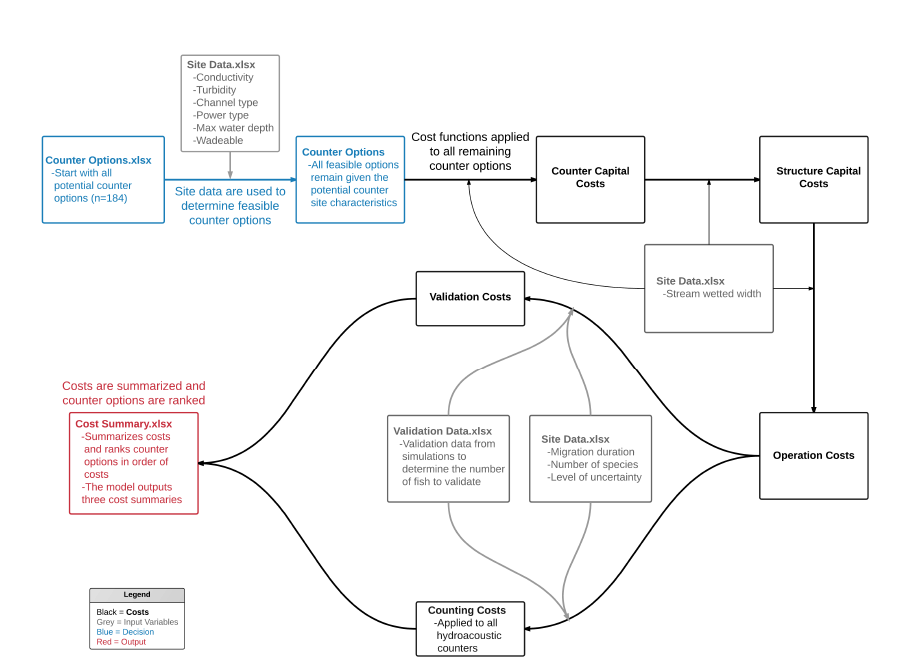
Figure 5.1. Flow diagram of the decision and cost model.
Table 5.1. Site Data.csv is available to download at http://dx.doi.org/10.7489/1689-1. Data were collected by IFR during site visits in October 2014. Description of variables can be found in Table 5.2.
Table 5.1. Descriptions of variables in Site Data.cvs file.
| Variable | Description |
| bfw | Maximum river wetted width before a river floods, or width of a fish pass, in meters (m) during the migration at the potential counter site. Possible inputs can be any value greater than 0. |
| conductivity | Lowest conductivity in micro Siemens (µS) observed during the migration in the past 10 years. Possible inputs can be any value greater than 0. If historical data does not exist, a minimum of one year of continuous monitor should be conducted. |
| turbidity | Highest turbidity in Nephelometric Turbidity Units ( NTU) observed during the migration in the past 10 years. If historical data does not exist, a minimum of one year of continuous monitor should be conducted. |
| max_depth | Maximum depth in meters (m) of a potential counter site during the migration. Possible inputs can be any value greater than 0. |
| channel_type | Type of channel the counter will be placed in - i.e., whether or not it is a fish pass or normal river channel. Possible inputs can be "fish pass" or "river". |
| existing_power_type | What is the existing power type at the potential counter site? Possible inputs can be "mains" or "none". |
| preferred_power_type | What is the preferred power type if there is no existing power at the potential counter site? Possible inputs can be "mains", "battery" or "either". |
| no_species | Number of species present during the migration that overlap in size. Possible inputs are any integer value equal to or greater than 1. |
| migration_length_day | Number of days from the start to the end of the migration. Possible inputs are any integer value equal to or greater than 1. |
| population_size_mean | Mean population size over the past 10 years. Possible inputs are any integer value equal to or greater than 1. |
| security_shed_present | Is a security shed (or related structure) at the potential counter site to place the counter and associated components? Possible inputs are "yes" or "no". |
| cellular_network | Is there a mobile phone reception within 50 m of the potential counter site? Possible inputs can be "yes" or "no". |
| uncertainty_metric | Metric used to determine the acceptable level of uncertainty. For example, if the acceptable level of uncertainty was for the mean estimated abundance to be within 5% of the true abundance, then the data input would be "mean". Alternatively, if the acceptable level of uncertainty was for estimates within ± 1 standard deviation from the mean to be within 5% of the true abundance, then the data input would be "sd". Possible inputs can be "mean" or "sd". |
| relative_error | Acceptable level of relative error in abundance estimates. For example, if the acceptable level of uncertainty was for the mean estimated abundance to be within 5% of the true abundance, then the data input would be "5". Possible inputs can be 5 or 10. |
| performance_metric | Metric used to characterize uncertainty. Possible inputs can be "accuracy", "precision", or "bias". |
| counter_accuracy | Is the counter accuracy predicted to be constant or variable? This is a function of water depth variability over or through the counter and the type of counter, and only applies to resistivity counters. Possible inputs can be "constant" or "variable". |
| counter_backup | Is a backup counter going to be purchased? Possible inputs can be "yes" or "no". |
| land_cost | What is the estimated cost of acquiring the land for the potential counter site? Possible inputs can be any value equal to or greater than 0. |
| wadeable | Is the average person able to safely wade across the river at any time during the migration? Possible inputs can be "yes" or no". |
Table 5.3. Counter Option.csv is available to download at http://dx.doi.org/10.7489/1689-1, and represents all counter options considered by the decision and cost model.
Table 5.2. Descriptions of variables in Counter Option.csv file.
| Variable | Description |
| option | Used to track the different options presented in the Counter Option.xlsx. |
| technology | Technology used to count or observe fish. Technologies considered are optical beam, hydroacoustic, and resistivity. |
| company | Company that manufactures counters. |
| company_risk | Risk level associated with the long-term persistence of a company and is proportional to company size (i.e., number of staff and infrastructure to support research, development, and support of their products). Low risk companies have ≥ 21 staff and large infrastructure; moderate risk companies have between 6 and 20 staff and moderate infrastructure; high risk companies have < 5 staff and little infrastructure. We considered EA Tech and SSE's Mark 12 counter to be moderate risk because EA Tech is contracted to make counters for SSE and there have been little to no sales or support of counters to groups outside of SSE. |
| counter | Specific manufacturer and model of counter. May also specify specific settings and the number of counters. We include only the most cost-effective counter models for simplicity. All models included have been extensively studied and used for stock assessment of salmonids. Note that this variable is used to track the different counter options in the model. |
| no_counter | Number of counters to be purchased and deployed. Extra counters here are not to be used for backup, but rather to extend the area or cross-section of the river monitored. If backup counters are required, this can be specified in the site data. |
| counter_cost | Cost of purchasing the counter and/or sensor in 2015. For counters originally quoted in USD, ( DIDSON 300 and BlueView M900-2250) a conversion of 1.64 USD to 1 GBP was used. For equipment sourced from the US, the price of any additional accessories needed, shipping, import duty and VAT would need to be added. |
| sensor | Type of sensor used with the counter. Potential sensor types are optical beam, multibeam, splitbeam, video, Crump weir, flat pad, flumes, and tubes. Resistivity counters rely on third party built sensor units (e.g., Crump weir, flat pad, tubes, and flumes). Cost of third party sensor units must be added to the counter cost (see sensor_cost_m variable). For other counter types that include the sensor unit (e.g., DIDSON 300, BlueView M900-2250, Riverwatcher, DTX-Echosounder and Video), the sensor units are included in the cost of the counter. Note that a Crump weir is also considered a structure (see structure variable), but it is useful to also consider it a sensor because it contains the electrodes for a resistivity counter. |
| channel_type | Type of channel the counter will be placed in. Important distinction is whether or not it is a fish pass or normal river channel. This will determine the type of structures available to install the counter. |
| structure | Type of structure to be used with the counter - may be required to fix the counter or sensor units into the river or fish pass (e.g., fish pass insert), or to improve counter accuracy by reducing the counting area of the river (e.g., picket fence or floating fence). Some structures contain the counter sensors (e.g., resistivity Crump weir, see sensor variable). |
| structure_risk | Level of risk of a structure failing or malfunctioning during the migration. All picket fences (i.e., diversion and full river spanning) are considered high risk because they are usually not permanent structures and are susceptible to high flows and debris. All floating fences are moderate risk because they can function well in high flows and debris, but still require a technician to monitor and clean the fence (much less frequently than a picket fence). Crump weirs and fish pass inserts are low risk because they are fixed into the river or fish pass. Having no structure is also low risk. Variable is not used in the model but is reported in the cost summary to help aid decisions. |
| counter_accuracy | Estimated counter accuracy (as a proportion of correctly counted records) for the technology, counter and structure used to deploy the counter. Estimates are based on IFR experience and the literature. Values for hydroacoustic technologies are set to zero because the counts are not automated and they are extremely difficult to validate. |
| structure_cost_fixed | Minimum cost of a structure. Mainly applies to the fish pass insert as it is a fixed cost and does not vary per meter like other structures. Also applies to a floating fence since it requires the construction of sidewalls regardless of fence width. |
| structure_cost | Per meter cost of a structure. Structure size is determined by the maximum bankfull width of the river during the migration, which is provided in Site Data.xlsx. If the cost per meter is linear, the per-meter cost is provided under the structure_cost_m variable (e.g., picket fence, floating fence). If the cost per meter is non-linear, a cost function is applied, which is embedded in the R code for the model. Cost function for the Crump weir is: Where y is the total cost for the Crump weir and x is the width (in meters) of the Crump weir required. |
| structure_pad | Denotes whether or not a concrete sill or chain ballast is to be used with a particular structure. For example, a concrete sill is a permanent structure that can be used to anchor a floating fence. A chain ballast is a semi-permanent structure that can anchor a floating fence. If no pad structure is to be used, the value is "none". |
| structure_pad_cost | Cost for a pad structure. Pad structure size is determined by the maximum bankfull width of the river during the migration, which is provided in Site_Data.xlsx. If the cost per meter is non-linear (concrete sill), a cost function is applied, which is embedded in the R code for the model. Cost function for the concrete sill is: Where y is the total cost and x is the width (in meters) of the concrete sill required. If the structure pad is a chain ballast, then the cost is fixed. |
| sensor_cost_fixed | Minimum cost of a sensor unit. This only applies to counters that require third party built sensor units (i.e., resistivity counters). See sensor for further discussion. |
| sensor_cost_m | Per meter cost for a sensor unit. Sensor size is determined by the maximum bankfull width of the river during the migration, which is provided in the Site_Data.xlsx. This only applies to flat pad resistivity sensors and the cost increases linearly per meter. |
| optimal_ww_sensor | Optimal sensor width in meters for a sensor unit to count fish. Value is used to determine the size of a picket or floating fence when it is being used as a diversion structure. |
| annual_install_bio_days | Number of biologist days required to install the counter and/or sensor unit each year. Annual cost that only applies to semi-permanent counters (items removed annually), sensors, and/or structures such as fences, sensor units in fish passes and flat pad sensors. For permanent structures, the removal cost is included in the structure_cost_fixed and the structure_cost_m is only applied once. Model assumes a day rate for a biologist to be £300. |
| annual_install_tech_days | Number of technician days to install the counter and/or sensor unit each year. Annual cost that only applies to semi-permanent counters (items installed annually), sensors, and/or structures such as fences, sensor units in fish passes and flat pad sensors. For permanent structures, the installation cost is included in the structure_cost_fixed and the structure_cost_m is only applied once. Model assumes a day rate for a technician to be £200. |
| annual_removal_bio_days | Number of biologist days required to remove the counter and/or sensor unit each year. Annual cost that only applies to semi-permanent counters (items removed annually), sensors, and/or structures such as fences, sensor units in fish passes and flat pad sensors. For permanent structures, the installation cost is included in the structure_cost_fixed and the structure_cost_m is only applied once. Model assumes a day rate for a biologist to be £300. |
| annual_removal_tech_days | Number of technician days to install and remove the counter and/or sensor unit each year. Annual cost that only applies to semi-permanent counters (items removed annually), sensors, and/or structures such as fences, sensor units in fish passes and flat pad sensors. For permanent structures, the installation cost is included in the structure_cost_fixed and the structure_cost_m is only applied once. Model assumes a day rate for a technician to be £200. |
| mounting_bracket_cost | A bracket that is used to mount hydroacoustic or video cameras in place. There are a wide range of options and costs, from inexpensive portable third party built units (£500) to expensive proprietary panning and tilting mounts that are fixed to lock blocks on the stream bank (£9500). We used the highest cost because it could be used at any counter site and under all water levels, whereas less expensive mounts will likely be site and water level specific in their application. |
| counter_service_cost_year | Cost for servicing the counter and/or sensor unit each year. Cost is applied annually and includes shipping costs. Costs are based on information gathered from direct communication with counter users or from manufacturers. Costs can vary greatly from year to year but these provide appropriate values when budgeting for maintenance. |
| computer_cost | Cost of a personal computer for operating all hydroacoustic counters. All other counters do not require a computer for operation. |
| data_storage_cost | Cost of four 4 TB hard drives. For most hydroacoustic and video applications, this is sufficient storage for one migration season. Hard drives can be traded out and data transferred to a server during the season. |
| downloading_freq_week | Number of days per week that a counter should be downloaded and the counter equipment checked during the migration. Frequency follows best practices. |
| power_type | Type of power available at the site. This removes counter options that do not match the existing_power_type specified in Site Data.xlsx. If no power options exist on site, the preferred_power_type entered in Site Data.xlsx is used to cost the installation of power. |
| no_battery | If the power_type is batteries, this provides the typical number of batteries that would be required to operate a counter setup for at least 7 days and the same number of backup batteries so that they can be switched out. We do not provide an estimate of the number of batteries for hydroacoustic counters because of their large power demands. Instead, a fixed cost of a generator is provided under power_install_cost. |
| battery_cost | Cost of one 12 V 40 Ah battery (£75) or one 12 V 80 Ah battery (£150). |
| power_install_cost | Cost of installing mains power or a generator at a site. Cost of installing mains power will be highly variable depending on the proximity of power. We used a rough estimate of £1000 for mains power. |
| remote_access_software_annual_cost | Annual cost of a remote download software program (e.g., Team Viewer). Software allows users to connect remotely to a computer in the field as long as there is cellular reception. |
| cell_plan_cost_month | Cost of a monthly cellular data plan with 1 GB of data. |
| cell_booster_cost | Cost of purchasing a cellular booster if there is not a cellular network. |
| site_visit_week_tech | Number of days per week a technician would visit a counter site to download data, check equipment, and clean counting structures and sensors. In all cases, we assume that two technicians will be visiting counter sites to ensure safe working conditions around water. If the value for this variable is one day, two technicians will visit the site for half a day. |
| permit_cost | This is the cost of permit applications to place a structure in a stream, see Appendix 3 for details. |
| permit_day | This is the number of days an engineer requires to complete all permit applications, which is estimate to be four. |
| counting_software | Software required for the counter to count fish. Optical beam and resistivity counters are automated and do not need additional software or people to count fish. Hydroacoustic technology produce images that either have to be viewed by a technician to count fish ("none") or processed through a program such as Echoview ("Echoview"). |
| counting_software_cost | One time cost of software that can be used for data management, data processing and count automation. |
| counting_effort | Amount of effort required to count fish using Echoview or counting manually. Units are provided in counting_effort_units and are either "fish per minute", "hours per day" or "none". Manual counts do not total a full day because footage is reviewed at 3 times more frames per second than it is recorded (i.e., footage is sped up). |
| security_shed_cost | One time cost of a steel security shed that can house counter equipment (length - 2.7 m x width - 1.5 m x height - 2.0 m). |
| validation_ type |
Typical type of validation associated with each counter. Only the Logie 2100C typically uses true validation through continuous video. Allows for estimates of abundance to represent the absolute abundance. Riverwatcher and Mark 12 use pseudo-validation through triggered video. This type of validation in most cases allows for estimates of abundance to represent the absolute abundance. DIDSON 300, BlueView M900-2250 and D-TX Echosounder are typically not validated because their typical application is in turbid rivers and it is difficult to impossible to validate. Lack of validation does not allow for absolute estimates of abundance; at best an index of abundance can be estimated. |
| validation_method | Typical method of validation for each counter (see validation_type). |
| validation_risk | Risk associated with not accounting for all sources of error in estimating counter accuracy from validation data. High validation risk is when there is not validation performed. Error rates cannot be estimated and the uncertainties in abundance estimates are unknown. |
| validation_equipment | Cost of video validation equipment (if required). For counters that include video validation equipment (e.g., Riverwatcher), the cost is included in the cost of the counter. Cost is for 4 underwater video cameras and 1 DVR. |
| validation_effort | Level of validation effort is the number of fish that can be validated per unit minute. This applies to optical beam and the Mark 12 resistivity counters, and is fixed at 6 fish per minute. Validation effort for the Logie 2100C resistivity counter is determined by the equation found in Section 4.2 Validation Costs (Equation 2). Hydroacoustic counters are not typically validated and therefore validation effort is not determined. |
| validation_effort_units | These are the units for validation effort (fish per minute). |
5.2 Cost Functions
The next step in the model is to calculate the costs for each remaining scenario. Costs are in the British Pound and were estimated using the 2015 Spon's Civil Engineering and Highway Works Price Book, and where prices were quoted in USD or CAD, conversions were applied (see Table 5.4). A series of cost functions are applied to each of the cost variables in the counter scenario. Many of the cost functions scale with the bankfull width of the potential site. For example, the cost of building a Crump weir for a resistivity counter, or a diversion fence to accompany a hydroacoustic counter, increases in cost for every additional meter of bankfull width. While the diversion fence increases at a linear rate, the Crump weir is a more complex non-linear function. Costs for validation are calculated using the validation data from simulations in Section 4.2, the number of fish to be validated based on counter, site, and management objectives can be found in Table 5.5. All cost functions are described in the variable descriptions in Table 5.4. The model outputs cost summaries including capital costs, 1-year operational costs, 1-year total costs (capital costs + 1-year operational costs), 10-year capital costs, 10-year operational costs and 10-year total (10-year capital costs + 10-year operational costs). For each of the case studies we present and evaluate the capital costs, 10-year operational costs, and the 10-year total costs.
Table 5.5 Validation Data.csv is available to download at http://dx.doi.org/10.7489/1689-1. These are the validation data used to determine the number of fish that should be validated.
5.3 Case Studies
In October 2014, IFR staff visited a number of potential counter sites throughout Scotland that serve as case studies to illustrate how the decision and cost model can be used. We present case studies of seven rivers that IFR visited (Figure 5.2). Potential sites were any sites identified and suggested by MSS staff (or fisheries board or trusts biologists) based on their knowledge of counter technologies and the river. If sites did not meet the criteria to be considered a counter site, they were eliminated from a full assessment. Sites and rivers were also eliminated if there was insufficient information collected during the site visit; these sites are discussed in the respective river's case study.
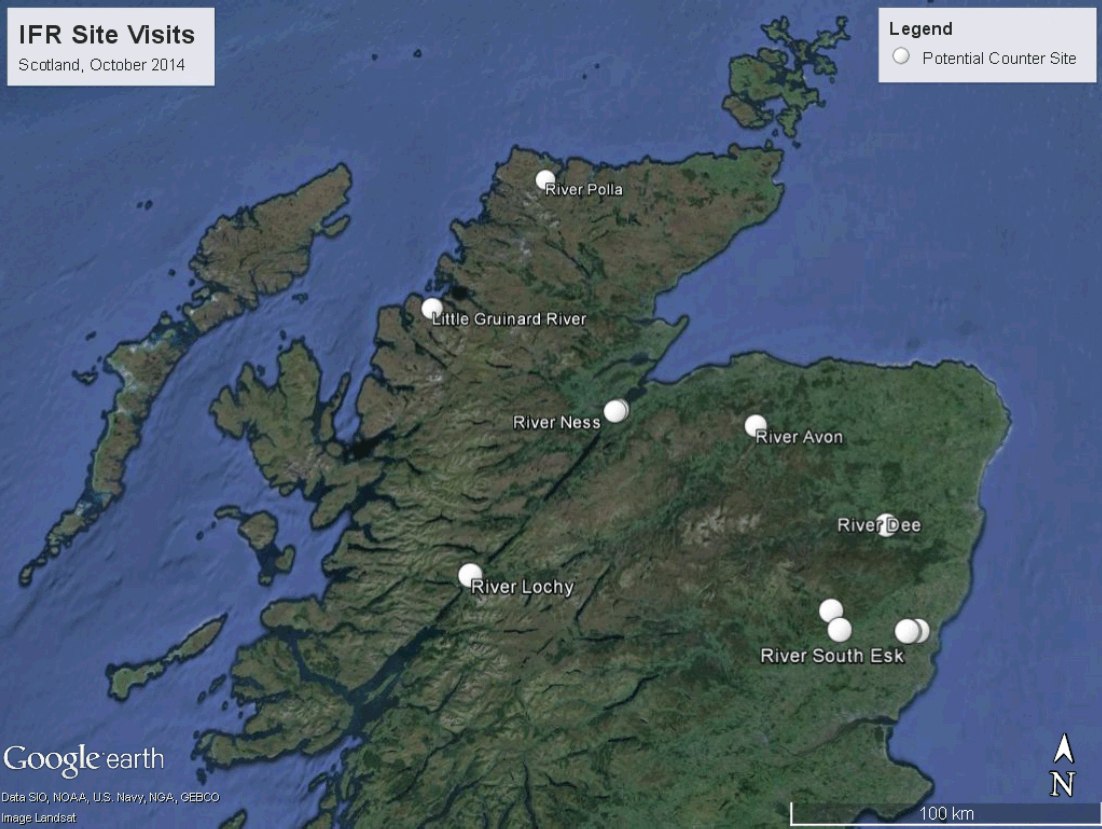
Figure 5.2. Map of Scottish rivers visited by IFR in October 2014.
Site visits were extremely successful and provided valuable information about the rivers and their populations of salmon, and a Scottish context for the development of the decision and cost model. Most visits consisted of an initial meeting with the fishery board or trust biologists, followed by one or more site visits. During the meetings and site visits, information about the watershed and populations were gleaned from staff members. One caveat to the information collected during the site visits is that most rivers in Scotland, including the majority of the rivers visited by IFR, were under extremely high flows. Consequently, this meant that most site assessments captured extreme conditions, which in some rivers made it difficult to assess site characteristics such as substrate composition. However, these extreme conditions demonstrate the inherent variability in environmental conditions (e.g., discharge, stage height, turbidity, and conductivity) that can be observed in a river, and highlights the importance of selecting counter setups that can operate effectively under even the most extreme conditions.
Data collected by IFR during site visits represents rough estimates and snapshots of the channel morphology and conditions at a site. Many of the variables were not measured accurately and assumptions were made, which are outlined here. IFR collected conductivity at each site but this was just a single measurement and is likely to change throughout the year and with changes in precipitation. IFR staff did not collect turbidity data during the site visits but instead made a qualitative visual assessment of water clarity. For example, water clarity was either clear or turbid. All clear rivers were given a value of 30 NTU and turbid rivers a value of 100 NTU since quantitative data are required for the model to assess different counter technologies. Depths of the specific site were not measured during the site visits and instead estimated based on the river channel characteristics and information gathered from local biologists.
Some variables are determined by the user considerations with regards to logistics and management objectives. For example, whether or not mains power or battery power should be used. In most sites mains power can be built into the site, while batteries could be used at all sites. For the case studies we assumed that mains power would be installed at all sites. If battery power was used it would change the absolute costs but they would likely maintain the same rank order for all cost summaries. For all case studies we included the cost of a backup counter. IFR highly recommends this especially since there is very little "off-season" for rivers in Scotland. We also assumed the same management assumptions for all case studies. Changing the level of acceptable uncertainty or the uncertainty metrics, however, would alter the costs since these variables are linked to the amount of validation required to achieve the specified level of uncertainty. We assumed land costs to be approximately £2000 to £5000, and used different values for some sites to test that the changes were being integrated into the costs.
Data were collected to provide some context for how to apply the counter decision and cost model to a potential site, and are not to be used as the actual site assessment. For accurate site assessments, IFR recommends collecting at least one year of data for environmental variables such as conductivity, turbidity, and stage height. We emphasize the importance of this step, as the model uses these parameters to determine the feasibility of technologies and structures. Furthermore, detailed cross-sectional surveys of channel morphology and substrate should also be conducted. Other important biological information to consider for a potential counter site are species composition, life history diversity, and overlap in length distributions and run timing. These factors can significantly alter the amount of time required for validation. This data collection will provide the necessary information for the model to be applied appropriately.
For each case study, we provide some basic information about the watershed, site and population characteristics, detailed site data used by the decision and cost model can be found in Table 5.1, and a summary in Table 5.6. Catchment area and discharge data presented herein were obtained from National River Flow Archive ( NRFA) gauging stations. We present the 50th percentile (Q50) discharge, as well as the range from the 5th percentile (Q95) to the 90th percentile (Q10) in text as Q50 (Q95 - Q10) (National River Flow Archive 2015). We then provide a qualitative assessment of the site based on IFR's professional experience with siting, installing, and operating fish counters. Finally, we assess the output of the decision and cost model, which includes making comparisons among feasible counter options based on the ranked order of counter scenarios with regards to capital costs, and 10-year operational and 10-year total costs. This is followed by a detailed description of the sites visited along with an assessment of the advantages and disadvantages of each site with regards to its potential as a counter site. Finally, the cost model output is discussed in the context of limited capital and operational budgets. Each case study ends with a recommendation about the best counter solutions based on the costs and IFR's professional experience.
Table 5.3. Summary of characteristics of potential counter sites visited by IFR staff in October 2014.
| Watershed | Site | Coordinates | Bankfull width (m) | Minimum depth (m) | Maximum depth (m) | Conductivity (μS) | Mains power | Species present | Run timing |
| River Avon | 1 | 57°24'58"N 3°22'38"W |
40 | 0.5 | 0.8 | 40 | No | 1 | Spring, Summer, Fall |
| River Ness | 1 | 57°28'02"N 4°13'44"W |
60 | 0.3 | 1.5 | 25 | No | 2 | Spring, Summer, Fall |
| 2 | 57°27'46"N 4°13'60"W |
35 | 1.5 | 3 | 25 | No | 2 | Spring, Summer, Fall | |
| 3 | 57°27'32"N 4°15'5"W |
30 | 1.5 | 3 | 25 | No | 2 | Spring, Summer, Fall | |
| Little Gruinard River | 1 | 57°50'57"N 5°28'2"W |
6 | 0.3 | 1 | 40 | No | 2 | Spring, Summer, Fall |
| 2 | 57°51'4"N 5°27'40"W |
8 | 0.9 | 1.5 | 40 | Yes | 2 | Spring, Summer, Fall | |
| River South-Esk | 1 | 56°46'30"N 3°1'40"W |
25 | 0.6 | 1.5 | 40 | Yes | 2 | Spring, Summer, Fall |
| 2 | 56°42'55"N 2°59'24"W |
15 | 0.3 | 1.8 | 30 | No | 2 | Spring, Summer, Fall | |
| 3 | 56°42'59"N 2°33'9"W |
40 | 0.3 | 1.5 | 150 | No | 2 | Spring, Summer, Fall | |
| 4 | 56°42'53"N 2°36'45"W |
3 | 0.3 | 0.6 | 150 | No | 2 | Spring, Summer, Fall | |
| 5 | 56°42'48"N 2°36'9"W |
30 | 0.6 | 1.5 | 150 | No | 2 | Spring, Summer, Fall | |
| River Lochy | 1 | 56°51'37"N 5°3'58"W |
10 | 1.5 | 2 | 40 | No | 2 | Spring, Summer, Fall |
| 2 | 56°51'31"N 5°4'21"W |
50 | 0.9 | 1.5 | 40 | No | 2 | Spring, Summer, Fall | |
| River Dee | 1 | 57°3'52"N 2°38'57"W |
50 | 0.6 | 1.8 | 40 | No | 2 | Spring, Summer, Fall |
| River Polla | 1 | 58°27'4"N 4°45'36"W |
20 | 0.3 | 0.6 | 40 | No | 2 | Summer, Fall |
5.3.1 River Avon
Watershed and Site Characteristics
River Avon is 30 km long, and has a catchment area of 543 km 2 and a discharge of 11 m 3s -1 (4-28 m 3s -1) at the Avon at Delnashaugh NRFA station (No. 8004) (Figure 5.3).
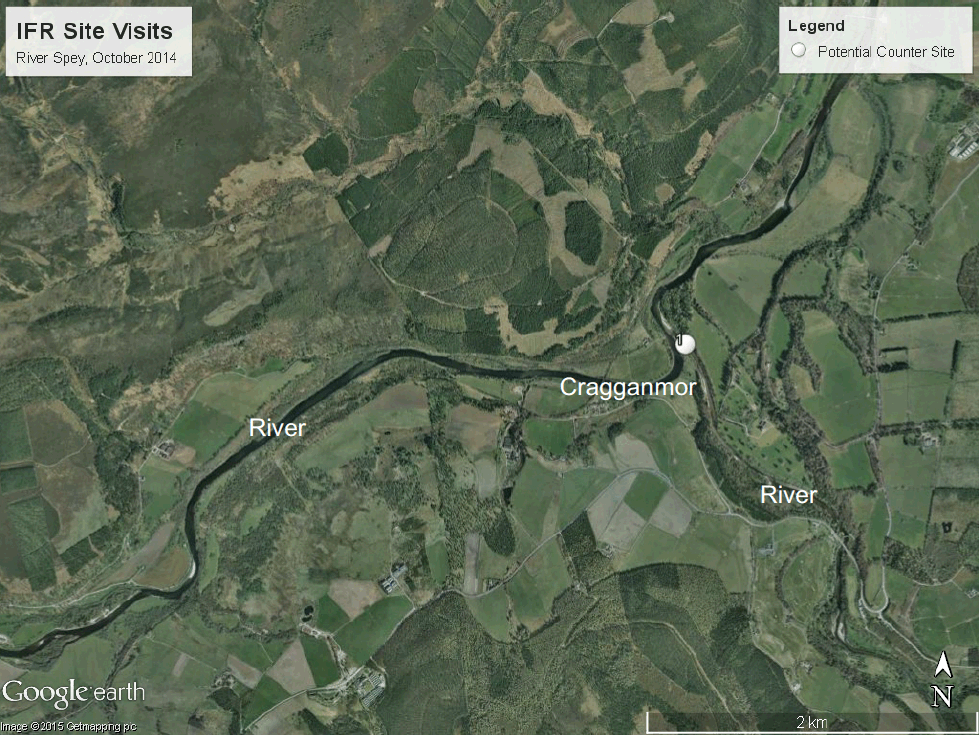
Figure 5.3. Potential counter site visited by IFR on River Avon, a major tributary of the River Spey.
Species and Run Timing
The River Spey and its tributaries supports one of the largest salmon populations in Scotland, where rod catches in 2014 totaled 4563 salmon (Spey Fishery Board 2015). River Spey also supports large populations of trout (sea trout rod catch of 2511 in 2014), which have overlapping size distributions and run timing (spring to fall) with salmon. The Spey Fishery Board ( SFB) biologists suggested that there were low numbers of brown trout in the River Avon. The species composition, life history diversity, and overlap in length distributions and migration timing are important considerations when selecting a counter. The species and run timing characteristics of the Avon (i.e., mainly one species) make validation relatively simple because species identification will not be a large component and thus the amount of time required for validation will be reduced. Notably, River Spey and its tributaries is a Special Area of Conservation ( SAC), with salmon spawning throughout the watershed.
IFR Site Visit
IFR visited River Avon with members of the Spey Fishery Board on 7 October 2014. The River Avon is a medium-sized river with low gradient at Site 1 ( Table 5.6) ( Figure 5.4). Spey Fishery Board biologists identified one potential counter site near the confluence with the River Spey ( Figure 5.3). While the site was under extremely high flows during the site visit, the general channel characteristics appeared to be suitable for a counter setup. The site was also below the lower extent of spawning which means the entire population would be counted in this location. One disadvantage of this site was that there was no mains power available, but it is close to houses and existing power lines and mains power could be added. Access to the site was good with a well-kept road that led directly to the counter site.
Model Output and Counter Evaluation for River Avon - Spey Confluence
The decision and cost model retained one technologically and logistically feasible counter scenario out of a possible 184 for the River Avon - River Spey confluence site (Table 5.7). The turbidity variable removed all counter scenarios that used optical beam and video counters because the turbidity values for the site were above both 90 and 30 NTU thresholds, respectively. The channel_type variable removed all counter scenarios where channel_type = "fish pass". Although there is no mains power at the site, mains power is possible and would be the preferred power_type. Thus, all counter scenarios with power_type = "battery" were removed. Max_depth variable removed all resistivity counters with flat pad sensors. The site is not always wadeable, and therefore the model removed all picket fence structure and resistivity flat pad sensor options. The variable used to remove the majority of the counter options was min_depth (> 90 cm min_depth required for hydroacoustic counters); this removed all counter options that used hydroacoustic technology.
A resistivity counter with a Crump weir was the only technologically and logistically feasible option, with capital, 10-year operational and 10-year total costs of £408 924, £123 684 and £532 607, respectively ( Table 5.7). While IFR agrees with the model output of a resistivity Crump weir counter setup, coarse site visit data may be the reason for only one feasible counter option at the River Avon. A more detailed site assessment that would include monitoring water conditions over time and more accurate depth measurements may reveal additional counter options.
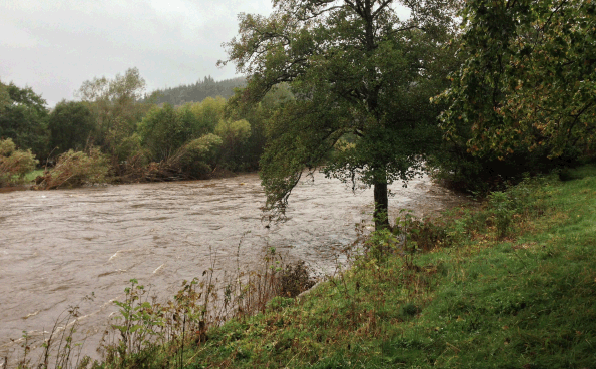
Figure 5.4. A potential counter site on the River Avon, October 2014. Photo courtesy of InStream Fisheries Research.
Table 5.4. Decision and cost model output for the River Spey confluence site on the River Avon. Options are ranked by 10-year total cost, from least to most expensive. Costs are provided in GBP, and cost rankings are provided in parentheses. Res. represents resolution.
| Option | Technology | Company | Res. | Counter | No. counters | Sensor | Structure | Structure pad | Counting software | Capital cost | 10-year operational cost | 10-year total cost |
|---|---|---|---|---|---|---|---|---|---|---|---|---|
| 93 | resistivity | Aquantic | NA | Logie 2100C | 1 | NA | Crump weir | none | automated | 408924 (1) | 123684 (1) | 532607 (1) |
5.3.2 River Ness
Watershed and Site Characteristics
River Ness is 20 km long, and has a catchment area of 1839 km 2 and a discharge of 67 m 3s -1 (20-183 m 3s -1) at the Ness-side NRFA station (No. 6007) (Figure 5.5). Discharge data from the Ness-side gauge station is applicable to the three potential counter sites visited by IFR staff.
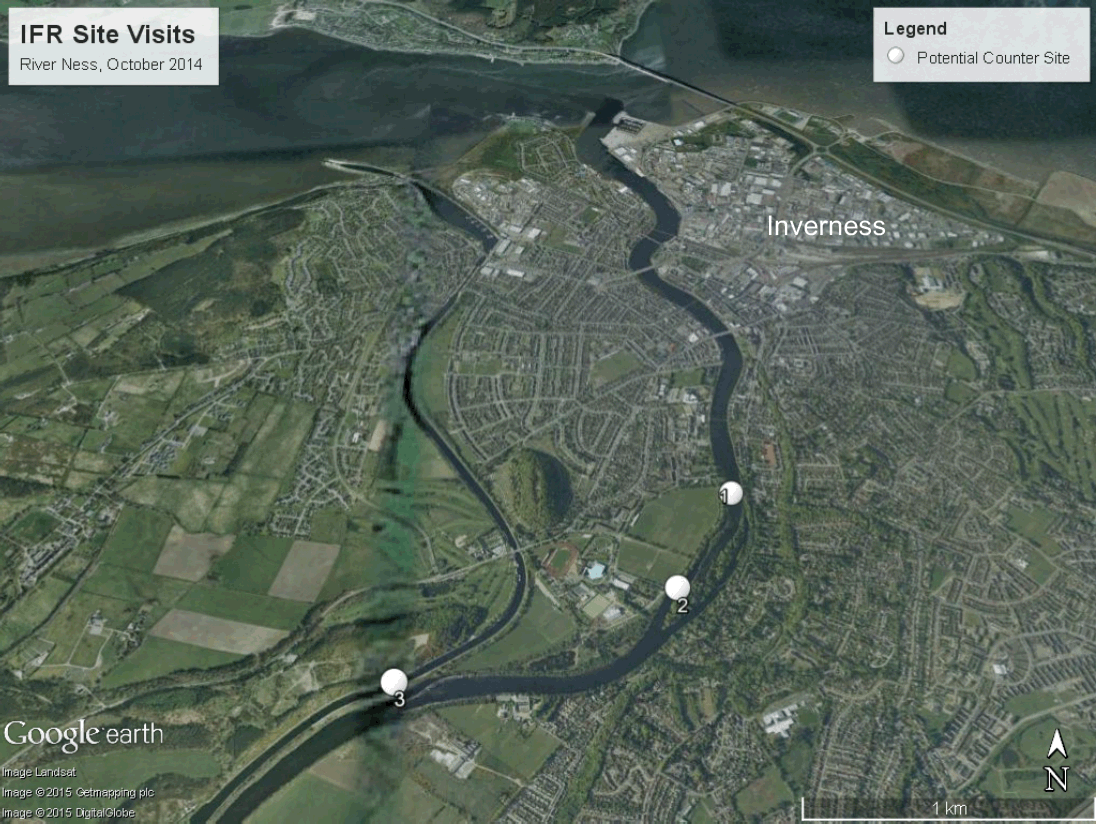
Figure 5.5. Potential counter sites visited by IFR on River Ness.
Species and Run Timing
Ness watershed supports modest numbers of salmon (~1000 rod caught salmon per year), as well as populations of brown trout, which have overlapping size distributions and run timing (spring to fall) with salmon. Loch Ness also supports ferox trout, which are cannibalistic brown trout that reach large sizes. This life history form can drop out from the loch into the River Ness and may complicate counts. Populations of Arctic char reside in Loch Ness but have not been found to use the River Ness for spawning (Ness District Fisheries Management Plan). Pike are also present in the Ness watershed and have been found in many of the lochs and rivers including River Ness. These large-bodied fish would be difficult to discriminate from salmon due to their size overlap, however the population of pike is believed to be very small. The species composition, life history diversity, and overlap in length distributions and migration timing are important considerations when selecting a counter. These characteristics can make it difficult to determine species identification throughout the salmon migration and it is important to select a counter scenario that allows for validation of species identification.
IFR Site Visit
IFR visited the three potential counter sites on River Ness with members of the Ness Fishery Trust staff on 8 October 2014 ( Figure 5.5). Site 1 was the Bught Park parking lot, Site 2 was the Gennel's Well footbridge, and Site 3 was the rock weir located approximately 1 km upstream of Site 2. Site 3 would require extensive changes to the rock weir to ensure fish are unable to pass during high flows; these costs are beyond the scope of the model and for this reason Site 3 was not considered further.
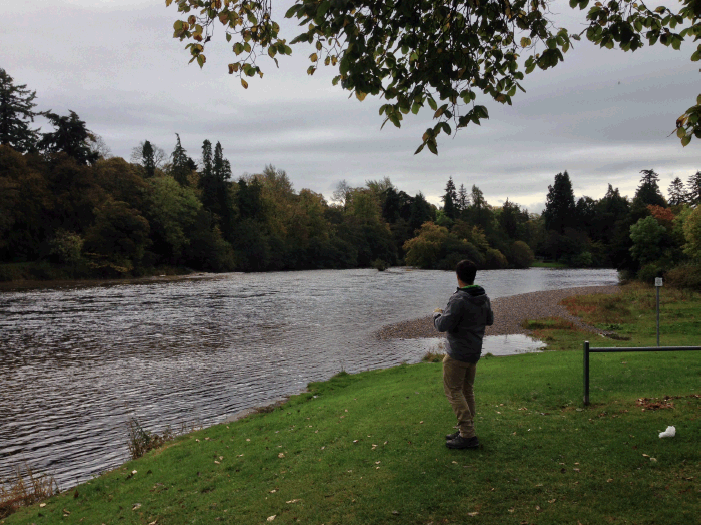
Figure 5.6. A potential counter site on the River Ness, October 2014. Photo courtesy of InStream Fisheries Research.
The main advantage of sites on the River Ness is that turbidity is extremely low all year round, because the turbidity is buffered by Loch Ness; this is a key characteristic for effective year-round video validation. A disadvantage of sites in the River Ness is its large bankfull width ( Figure 5.6). Installing a counter at Site 1 is feasible, but this site has a very large bankfull width and would likely only be operable as a counter site by using two mulitbeam sonar counters and a diversion fence, or a split beam counter and a diversion fence. Site 2 also has potential as a counter site but may be problematic because this site has two channels as the river splits just upstream of the footbridge. One option would be to operate two counters, one on each channel; the model was not able to deal with the two channels in one costing but could be applied to each channel separately and the costs summed. This approach would ignore a number of operational cost savings and would likely lead to overestimating operation costs. An alternative solution would be to operate one counter and tag fish downstream and use telemetry to estimate the proportion of fish that migrate up the channel without a counter. We did not apply the model to Site 2 for the aforementioned reasons. While this approach introduces other logistical and potential economic challenges that cannot be accounted for in the model, it would provide additional biological data that could be useful for understanding salmon behavior. Another major disadvantage of the River Ness sites are their exposure to the public and the associated security risk to equipment. Both Site 1 and 2 can be easily accessed by the public; this should be a major consideration when making decisions about a site.
Model Output and Counter Evaluation for River Ness - Bught Park
The decision and cost model retained 44 technologically and logistically feasible counter scenarios out of a possible 184 for the River Ness Bught Park site ( Table 5.8). The channel_type variable removed all counter scenarios where channel_type = "fish pass". Additionally there is mains power at the site, so all counter scenarios with power_type = "battery" were removed. The max_depth variable removed all scenarios with sensor as a "flat pad" since the maximum depth of the site is greater than 1 m. The river is not wadeable, so sensors that were flat pad were removed along with structures that were "picket fence". Finally, any counter scenarios that had a maximum sensor width less than the bankfull width of the site and did not have a fence structure were removed. Fences allow the counter width to be expanded and therefore can be used in large rivers.
Limited Capital Budgets
The five least expensive options include hydroacoustic and video counters, varying in the types of structures and manufacturers. Video counter scenarios offer the least expensive capital costs starting at £57 730, followed by hydroacoustic D-TX Echosounder at £89 557 (Table 5.8). Options 3 to 5 included hydroacoustic counters Teledyne BlueView and BioSonics, and ranged from £89 707 to £97 806. Video is not recommended for this site because of the inherent challenges with regards to capturing the entire cross-section of such a large river. Although the third to fifth scenarios with the least expensive capital cost are feasible, we do not recommend these counter scenarios because they have only one counter. For this site, the two hydroacoustic (e.g., DIDSON 300 or BlueView M900-2250) units are required when operating the unit under low resolution. This would reduce the amount of fence required and minimize risk. The scenario with the second least expensive capital cost is the D-TX Echosounder, which has an exceptional optimal sensor range (100 m), but little research has been conducted on the effectiveness of this counter. The least expensive counter scenario with two hydroacoustic counters is the BlueView M900-2250 with a floating fence, but no Echoview software to perform semi-automated counts at £102 854. A similar scenario, but instead with a DIDSON 300 counter, would cost £186 853. Counter scenarios ranked six through 44 ranged in capital costs from £101 453 to £1 326 728. Exceptionally high capital costs are associated with building a concrete sill, which is > £1 million. Due to the large bankfull width of the River Ness, many of the counter scenarios would perform less than optimal and the amount of fence required would be logistically difficult and have a high risk of failure. This case study highlights the limitation of the model in that it performs poorly with large sites. Most large sites (i.e., bankfull width > 50 m) would benefit from additional assessment.
Limited Operations Budgets
The five least expensive options over a 10-year operational period include hydroacoustic BlueView M900-2250 and optical beam Riverwatcher ( Table 5.8). Despite their low operational costs, Riverwatcher counters are not well suited for this site and therefore we focus our assessment of operational costs on the variation in hydroacoustic counter operation costs. The most viable hydroacoustic counter scenarios with regards to operation costs all include Echoview software that semi-automates counting fish. The operational costs for counter scenarios without Echoview are 3-fold higher; operational costs for all hydroacoustic counters without Echoview ranged from £1 836 150 to £1 846 150. Echoview greatly reduces the time required to review hydroacoustic data and count fish.
The total cost over 10-years (including capital and 10-year operational costs) ranged from £734 337 to £849 205 for the top-ten ranked hydroacoustic counter scenarios, with scenarios ranked 11 through 38 having a total cost ranging from £1 853 010 to £3 148 898 ( Table 5.8). We recommend that hydroacoustic counter scenarios that include two counters and Echoview software be considered for Site 1 - the Bught Park site on the River Ness.
Table 5.5. Decision and cost model output for the Bught Park site on the River Ness. Options are ranked by 10-year total cost, from least to most expensive. Costs are provided in GBP, and cost rankings are provided in parentheses. Res. represents resolution.
| Option no. | Technology | Company | Res. | Counter | No. counters | Sensor | Structure | Structure pad | Counting software | Capital cost | 10-year operational cost | 10-year total cost |
|---|---|---|---|---|---|---|---|---|---|---|---|---|
| 108 | optical beam | Vaki | NA | Riverwatcher | 1 | NA | floating fence | chain ballast | automated | 101453 (6) | 133552 (1) | 235005 (1) |
| 116 | optical beam | Vaki | NA | Riverwatcher | 2 | NA | floating fence | chain ballast | automated | 128453 (14) | 133552 (2) | 262005 (2) |
| 32 | hydroacoustic | Teledyne BlueView | low | BlueView | 1 | NA | floating fence | chain ballast | Echoview | 102187 (8) | 642650 (5) | 734337 (3) |
| 40 | hydroacoustic | Teledyne BlueView | high | BlueView | 1 | NA | floating fence | chain ballast | Echoview | 109286 (11) | 642650 (6) | 741436 (4) |
| 13 | hydroacoustic | BioSonics | low | D-TX | 1 | NA | none | none | Echoview | 102037 (7) | 650650 (17) | 741737 (5) |
| 16 | hydroacoustic | BioSonics | low | D-TX | 1 | NA | floating fence | chain ballast | Echoview | 104037 (10) | 652650 (18) | 745737 (6) |
| 48 | hydroacoustic | Teledyne BlueView | low | BlueView | 2 | NA | floating fence | chain ballast | Echoview | 115334 (12) | 642650 (7) | 746484 (7) |
| 56 | hydroacoustic | Teledyne BlueView | high | BlueView | 2 | NA | floating fence | chain ballast | Echoview | 131532 (15) | 642650 (8) | 762682 (8) |
| 4 | video | various | NA | various | 1 | NA | floating fence | chain ballast | none | 57730 (1) | 721864 (24) | 778694 (9) |
| 124 | hydroacoustic | Sound Metrics | low | DIDSON 300 | 1 | NA | floating fence | chain ballast | Echoview | 157148 (18) | 647650 (13) | 794298 (10) |
| 132 | hydroacoustic | Sound Metrics | high | DIDSON 300 | 1 | NA | floating fence | chain ballast | Echoview | 161509 (19) | 647650 (14) | 798659 (11) |
| 140 | hydroacoustic | Sound Metrics | low | DIDSON 300 | 2 | NA | floating fence | chain ballast | Echoview | 199333 (22) | 652650 (19) | 840483 (12) |
| 148 | hydroacoustic | Sound Metrics | high | DIDSON 300 | 2 | NA | floating fence | chain ballast | Echoview | 208055 (23) | 652650 (20) | 849205 (13) |
| 107 | optical beam | Vaki | NA | Riverwatcher | 1 | NA | floating fence | concrete sill | automated | 1220126 (28) | 133552 (3) | 1353678 (14) |
| 115 | optical beam | Vaki | NA | Riverwatcher | 2 | NA | floating fence | concrete sill | automated | 1247126 (35) | 133552 (4) | 1380678 (15) |
| 31 | hydroacoustic | Teledyne BlueView | low | BlueView | 1 | NA | floating fence | concrete sill | Echoview | 1220860 (29) | 642650 (9) | 1853010 (16) |
| 39 | hydroacoustic | Teledyne BlueView | high | BlueView | 1 | NA | floating fence | concrete sill | Echoview | 1227959 (32) | 642650 (10) | 1860109 (17) |
| 15 | hydroacoustic | BioSonics | low | D-TX | 1 | NA | floating fence | concrete sill | Echoview | 1222710 (31) | 652650 (21) | 1864410 (18) |
| 47 | hydroacoustic | Teledyne BlueView | low | BlueView | 2 | NA | floating fence | concrete sill | Echoview | 1234007 (33) | 642650 (11) | 1865157 (19) |
| 55 | hydroacoustic | Teledyne BlueView | high | BlueView | 2 | NA | floating fence | concrete sill | Echoview | 1250205 (36) | 642650 (12) | 1881355 (20) |
| 3 | video | various | NA | various | 1 | NA | floating fence | concrete sill | none | 1176403 (24) | 721864 (25) | 1897367 (21) |
| 123 | hydroacoustic | Sound Metrics | low | DIDSON 300 | 1 | NA | floating fence | concrete sill | Echoview | 1275821 (39) | 647650 (15) | 1912971 (22) |
| 64 | hydroacoustic | Teledyne BlueView | low | BlueView | 1 | NA | floating fence | chain ballast | none | 89707 (3) | 1836150 (26) | 1915357 (23) |
| 131 | hydroacoustic | Sound Metrics | high | DIDSON 300 | 1 | NA | floating fence | concrete sill | Echoview | 1280182 (40) | 647650 (16) | 1917332 (24) |
| 21 | hydroacoustic | BioSonics | low | D-TX | 1 | NA | none | none | none | 89557 (2) | 1844150 (38) | 1922757 (25) |
| 72 | hydroacoustic | Teledyne BlueView | high | BlueView | 1 | NA | floating fence | chain ballast | none | 97806 (5) | 1836150 (27) | 1923456 (26) |
| 24 | hydroacoustic | BioSonics | low | D-TX | 1 | NA | floating fence | chain ballast | none | 91557 (4) | 1846150 (39) | 1926757 (27) |
| 80 | hydroacoustic | Teledyne BlueView | low | BlueView | 2 | NA | floating fence | chain ballast | none | 102854 (9) | 1836150 (28) | 1927504 (28) |
| 88 | hydroacoustic | Teledyne BlueView | high | BlueView | 2 | NA | floating fence | chain ballast | none | 119052 (13) | 1836150 (29) | 1943702 (29) |
| 139 | hydroacoustic | Sound Metrics | low | DIDSON 300 | 2 | NA | floating fence | concrete sill | Echoview | 1318006 (43) | 652650 (22) | 1959156 (30) |
| 147 | hydroacoustic | Sound Metrics | high | DIDSON 300 | 2 | NA | floating fence | concrete sill | Echoview | 1326728 (44) | 652650 (23) | 1967878 (31) |
| 156 | hydroacoustic | Sound Metrics | low | DIDSON 300 | 1 | NA | floating fence | chain ballast | none | 144668 (16) | 1841150 (34) | 1975318 (32) |
| 164 | hydroacoustic | Sound Metrics | high | DIDSON 300 | 1 | NA | floating fence | chain ballast | none | 149029 (17) | 1841150 (35) | 1979679 (33) |
| 172 | hydroacoustic | Sound Metrics | low | DIDSON 300 | 2 | NA | floating fence | chain ballast | none | 186853 (20) | 1846150 (40) | 2021503 (34) |
| 180 | hydroacoustic | Sound Metrics | high | DIDSON 300 | 2 | NA | floating fence | chain ballast | none | 195575 (21) | 1846150 (41) | 2030225 (35) |
| 63 | hydroacoustic | Teledyne BlueView | low | BlueView | 1 | NA | floating fence | concrete sill | none | 1208380 (25) | 1836150 (30) | 3034030 (36) |
| 71 | hydroacoustic | Teledyne BlueView | high | BlueView | 1 | NA | floating fence | concrete sill | none | 1216479 (27) | 1836150 (31) | 3042129 (37) |
| 23 | hydroacoustic | BioSonics | low | D-TX | 1 | NA | floating fence | concrete sill | none | 1210230 (26) | 1846150 (42) | 3045430 (38) |
| 79 | hydroacoustic | Teledyne BlueView | low | BlueView | 2 | NA | floating fence | concrete sill | none | 1221527 (30) | 1836150 (32) | 3046177 (39) |
| 87 | hydroacoustic | Teledyne BlueView | high | BlueView | 2 | NA | floating fence | concrete sill | none | 1237725 (34) | 1836150 (33) | 3062375 (40) |
| 155 | hydroacoustic | Sound Metrics | low | DIDSON 300 | 1 | NA | floating fence | concrete sill | none | 1263341 (37) | 1841150 (36) | 3093991 (41) |
| 163 | hydroacoustic | Sound Metrics | high | DIDSON 300 | 1 | NA | floating fence | concrete sill | none | 1267702 (38) | 1841150 (37) | 3098352 (42) |
| 171 | hydroacoustic | Sound Metrics | low | DIDSON 300 | 2 | NA | floating fence | concrete sill | none | 1305526 (41) | 1846150 (43) | 3140176 (43) |
| 179 | hydroacoustic | Sound Metrics | high | DIDSON 300 | 2 | NA | floating fence | concrete sill | none | 1314248 (42) | 1846150 (44) | 3148898 (44) |
5.3.3 Little Gruinard River
Watershed and Site Characteristics
Little Gruinard River is a small river; it has a catchment area of 81 km 2, is fed by a series of large lochs, and has low levels of species diversity and productivity (Figure 5.7). Currently, there are no SEPA gauging stations on the Little Gruinard River.
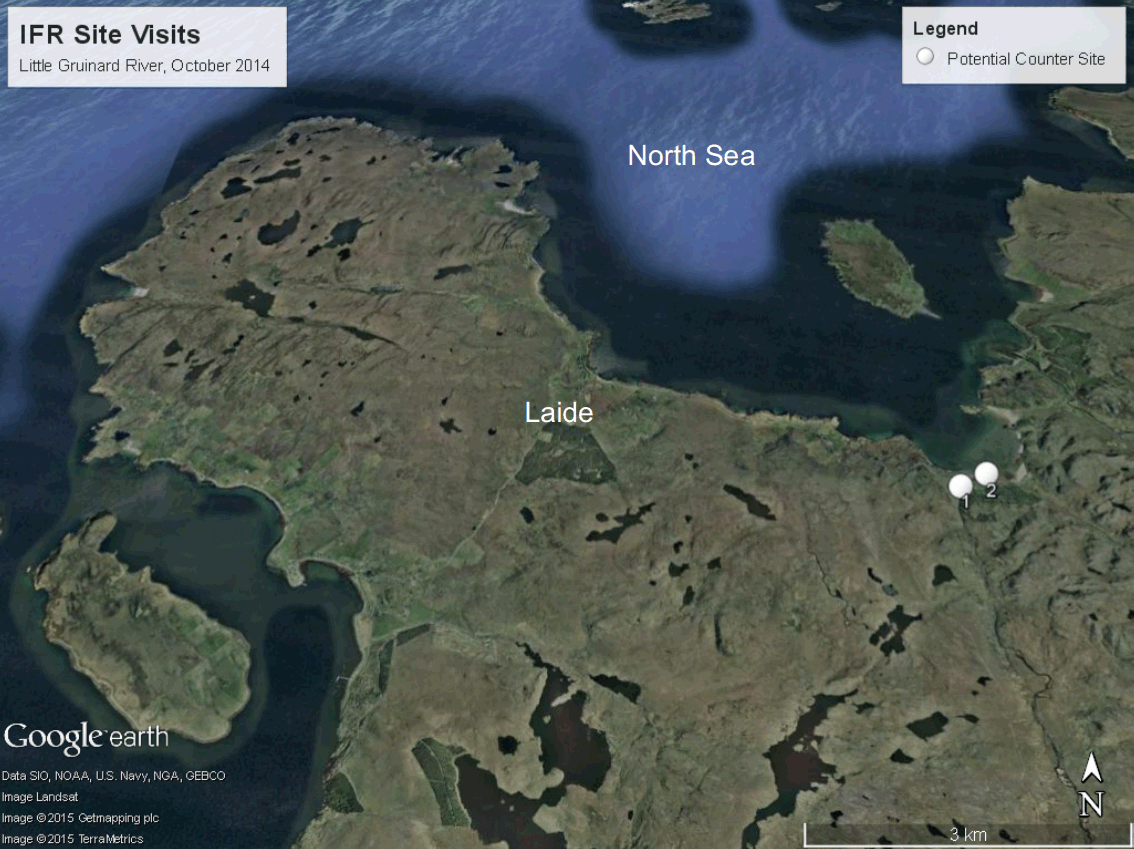
Figure 5.7. Potential counter sites visited by IFR on Little Gruinard River.
Species and Run Timing
Little Gruinard River supports salmon and trout, which have overlapping size distributions and run timing (spring to fall). Salmon returns in the Little Gruinard River total approximately 100 fish annually. The Little Gruinard River is a SAC for salmon, where the population is predominantly grilse with some two sea-winter adults present. The species composition, life history diversity, and overlap in length distributions and migration timing are important considerations when selecting a counter. These characteristics can make it difficult to determine species identification throughout the salmon migration and it is important to select a counter scenario that allows for validation of species identification.
IFR Site Visit
IFR staff visited two potential counter sites on Little Gruinard. For this site visit, Donna-Claire Hunter, the project coordinator for Marine Scotland Science, hosted IFR on the Little Gruinard River and little information was available on run timing and species composition. Site 1 was located at a bridge on Highway A832, and Site 2 was < 50 m upstream of Gruinard Bay ( Figure 5.7).
Site 1 was a high gradient, boulder section of the river that would make the operation of a counter difficult given the substrate ( Figure 5.8). Old bridge posts on both sides of the river, however, may provide a constrained and consistent cross-section of the river for sonar to be operated. Mains power would also need to be installed. Although this site has potential as a counter site, Site 2 was much better suited and Site 1 was not considered further.
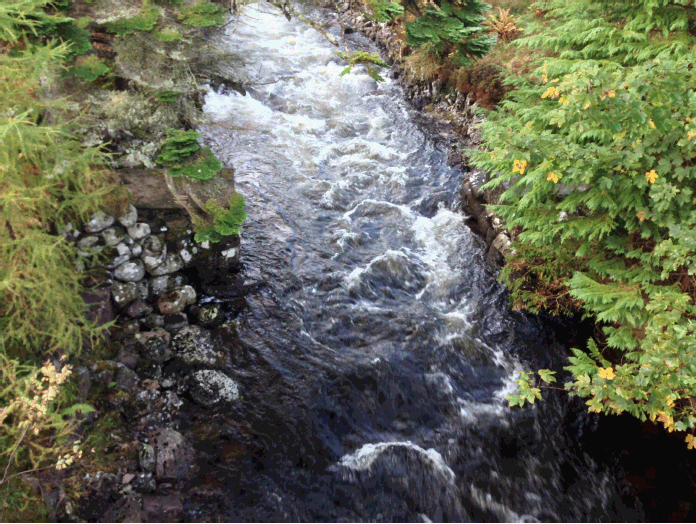
Figure 5.8. A potential counter site on the Little Gruinard River (Site 1), October 2014. Photo courtesy of InStream Fisheries Research.
Site 2 was a lower gradient, cobble and bolder section of the river that would be highly suitable for a counter setup ( Figure 5.9). Main advantages of this site were the small channel width, availability of mains power, location relative to spawning and site access. Channel morphology is relatively uniform, and shallow with a narrow bankfull width. Such channel characteristics make it easy to install and operate counters, including operation of a diversion fence if one were required. Site 2 is located on a property with mains power and is below the lowest extent of spawning, with good access. Security for this site would likely not be an issue. IFR was able to drive vehicles close to the site and access it along the property owner's road, reducing the time and challenge of carrying gear into the site, checking the counter and potential security issues. Access to this site makes batteries a viable option in the absence of mains power, however the remote location would add substantial travel time if staff were not local.
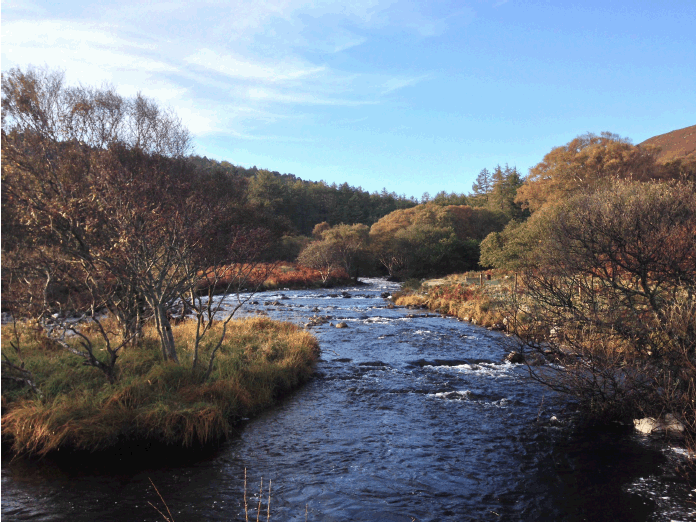
Figure 5.9. A potential counter site on the Little Gruinard River (Site 2), October 2014. Photo courtesy of InStream Fisheries Research.
Model Output and Counter Evaluation for Little Gruinard - Ocean Confluence
The model retained nine technologically and logistically feasible counter scenarios out of a possible 184 for the ocean confluence site on Little Gruinard River ( Table 5.9). The channel_type variable removed all counter scenarios where channel_type = "fish pass". Additionally there is mains power at the site, so all counter scenarios with power_type = "battery" were removed. The main variable use to remove the majority of the counter options was min_depth (> 90 cm min_depth required for hydroacoustic counters); this removed all counter options that used hydroacoustic technology.
Limited Capital Budgets
The five least expensive options include resistivity, optical beam and video counters, varying in the types of structures and sensor units. Video counter scenarios offer the least expensive capital costs starting at £25 580, followed by resistivity counters with flat pad sensors at £29 623 and £30 303 for the 2 nd and 3 rd ranked options ( Table 5.9). Although the optical beam counter is ranked fourth, the capital cost is 2.8- and 2.3-fold greater than video counters and resistivity, respectively. The reason for this large difference in capital cost is due to the large cost of the Vaki Riverwatcher counter unit. From a capital cost perspective, the model results indicate that video and resistivity technologies would be the most cost-effective options.
Limited Operational Budgets
The five least expensive options over a 10-year operational period include resistivity and optical beam counters (Table 5.9). The large cost of operating video counters, attributable to the cost of reviewing video footage to count fish, lead to the worst cost rankings over a 10-year operational period and are typically 5-fold higher than the operational costs associated with the optical beam and resistivity counter setups.
The total cost over 10-years (including capital and 10-year operational costs) ranged from £123 666 to £252 258 for the top seven ranked scenarios, with scenarios ranked eight through nine having a total cost > £534 905 (Table 5.9). Scenarios ranked eight through nine all use video technology and the high cost over 10 years is attributable to the high cost of reviewing video to count fish. We recommend that the top seven ranked scenarios be considered for Site 2 - the ocean confluence site on the Little Gruinard River.
Table 5.6. Decision and cost model output for the ocean confluence site on Little Gruinard River. Options are ranked by 10-year total cost, from least to most expensive. Costs are provided in GBP, and cost rankings are provided in parentheses. Res. represents resolution.
| Option no. | Technology | Company | Res. | Counter | No. counters | Sensor | Structure | Structure pad | Counting software | Capital cost | 10-year operational cost | 10-year total cost |
|---|---|---|---|---|---|---|---|---|---|---|---|---|
| 95 | resistivity | Aquantic | NA | Logie 2100C | 1 | flat pad | none | none | automated | 29623 (2) | 94043 (2) | 123666 (1) |
| 97 | resistivity | Aquantic | NA | Logie 2100C | 1 | flat pad | picket fence | none | automated | 30303 (3) | 102499 (7) | 132802 (2) |
| 108 | optical beam | Vaki | NA | Riverwatcher | 1 | NA | floating fence | chain ballast | automated | 69303 (4) | 97538 (3) | 166840 (3) |
| 116 | optical beam | Vaki | NA | Riverwatcher | 2 | NA | floating fence | chain ballast | automated | 96303 (6) | 97538 (4) | 193840 (4) |
| 93 | resistivity | Aquantic | NA | Logie 2100C | 1 | NA | Crump weir | none | automated | 121494 (7) | 90680 (1) | 212174 (5) |
| 107 | optical beam | Vaki | NA | Riverwatcher | 1 | NA | floating fence | concrete sill | automated | 127721 (8) | 97538 (5) | 225258 (6) |
| 115 | optical beam | Vaki | NA | Riverwatcher | 2 | NA | floating fence | concrete sill | automated | 154721 (9) | 97538 (6) | 252258 (7) |
| 4 | video | various | NA | various | 1 | NA | floating fence | chain ballast | none | 25580 (1) | 510225 (8) | 534905 (8) |
| 3 | video | various | NA | various | 1 | NA | floating fence | concrete sill | none | 83998 (5) | 510225 (9) | 593323 (9) |
5.3.4 River South Esk
Watershed and Site Characteristics
River South Esk at the Gella Bridge NRFA station (No. 13012) has a catchment area of 130 km 2 and a discharge of 3 m 3s -1 (1-12 m 3s -1) ( Figure 5.10). Discharge data from Gella Bridge is applicable to the Clova Bridge site (Site 1) on River South Esk visited by IFR staff.
River South Esk at the Prosen Bridge NRFA station (No. 13004) has a catchment area of 104 km 2 and a discharge of 2 m 3s -1 (0.7-7 m 3s -1) ( Figure 5.10).
River South Esk at the Brechin NRFA station (No. 13008) has a catchment area of 488 km 2 and a discharge of 9 m 3s -1 (2-27 m 3s -1) ( Figure 5.10). Discharge data from Brechin is applicable to the South Esk Bridge of Dun (Site 3), weir (Site 4) and footbridge (Site 5) sites visited by IFR staff.
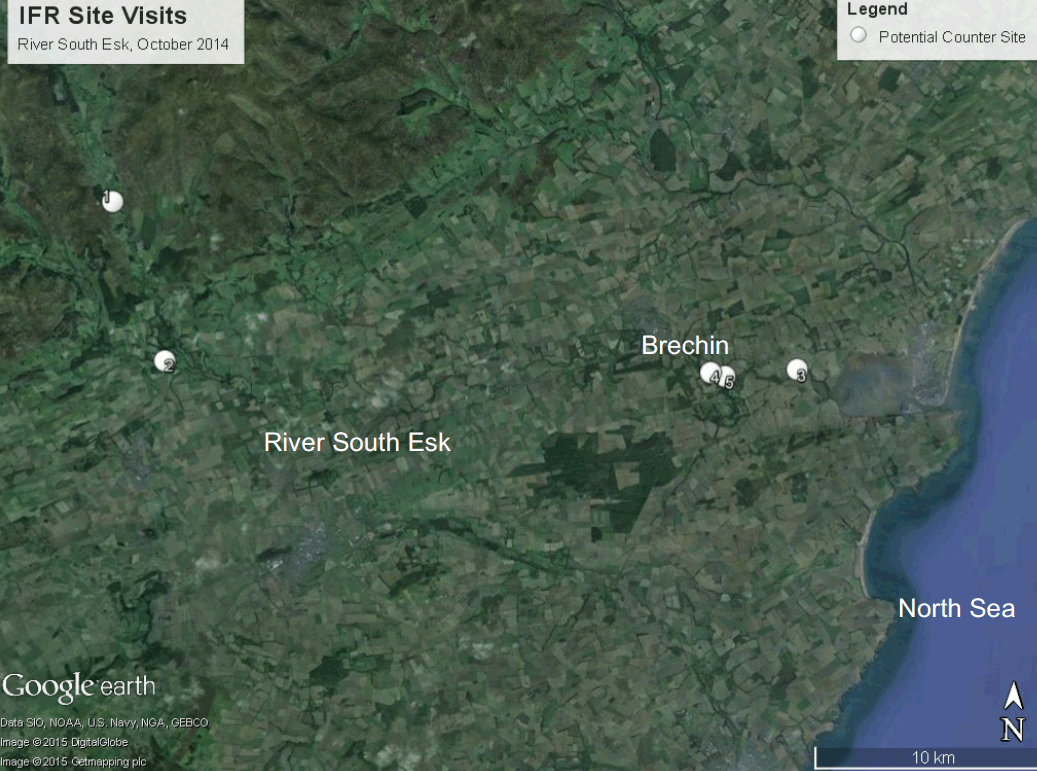
Figure 5.10. Potential counter sites visited by IFR on River South Esk.
Species and Run Timing
River South Esk supports salmon and trout, which have overlapping size distributions and run timing (spring to fall). Subpopulations of spring and summer salmon, and grilse are all present in River South Esk. River South Esk is a SAC for salmon. Rod catches for salmon and sea trout in 2013 were approximately 500 fish for both species (Esk Rivers and Fisheries Trust 2014). Historically, rod catches have been between 500 and 3000, and 100 and 1500 for salmon and sea trout, respectively.
IFR Site Visit
IFR staff visited five potential sites in the River South Esk watershed - Site 1 the Clova Bridge ( Figure 5.11 and 5.12), Site 2 the Prosen Bridge ( Figure 5.13 and 5.14), Site 3 the Dun Bridge, Site 4 the River South Esk weir ( Figure 5.15), and Site 5 the River South Esk footbridge ( Figure 5.16). All sites except Site 3 could be potential counter sites, but varied in their channel characteristics significantly. Site 3 was tidal, which would be too difficult because of changing water levels and conductivity and therefore was not considered further.
Site 1 at the Clova Bridge was a lower gradient section of river with boulder substrate downstream of the bridge and gravel upstream of the bridge ( Figure 5.11 and 5.12). The medium-sized channel width at Site 1 was appropriate for a range of counter designs. During the site visit the water was turbid, which could make video validation difficult. There is no mains power but the site is in close proximity to power lines. Access to the site was good. The main disadvantage of the Site 1 is the exposure to the public and associated security risk to equipment. The public can easily access Site 1 as it is located next to a car park and a frequently used road bridge; this should be a major consideration when making decisions about a site. Access to this site makes batteries a viable option in the absence of mains power.
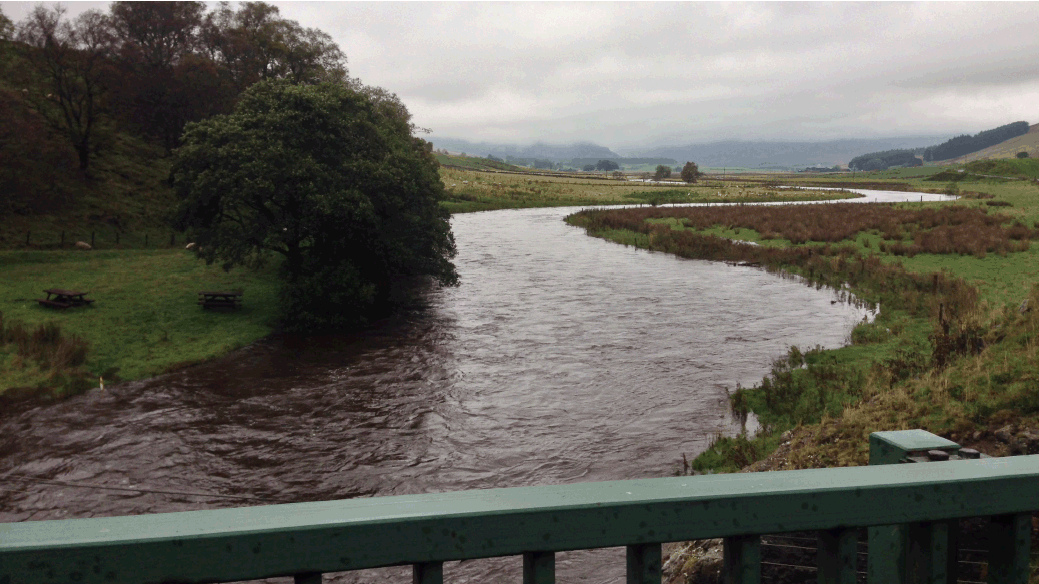
Figure 5.11. Clova Bridge, a potential counter site on River South Esk. This picture shows the river upstream of the bridge. Photo courtesy of InStream Fisheries Research.
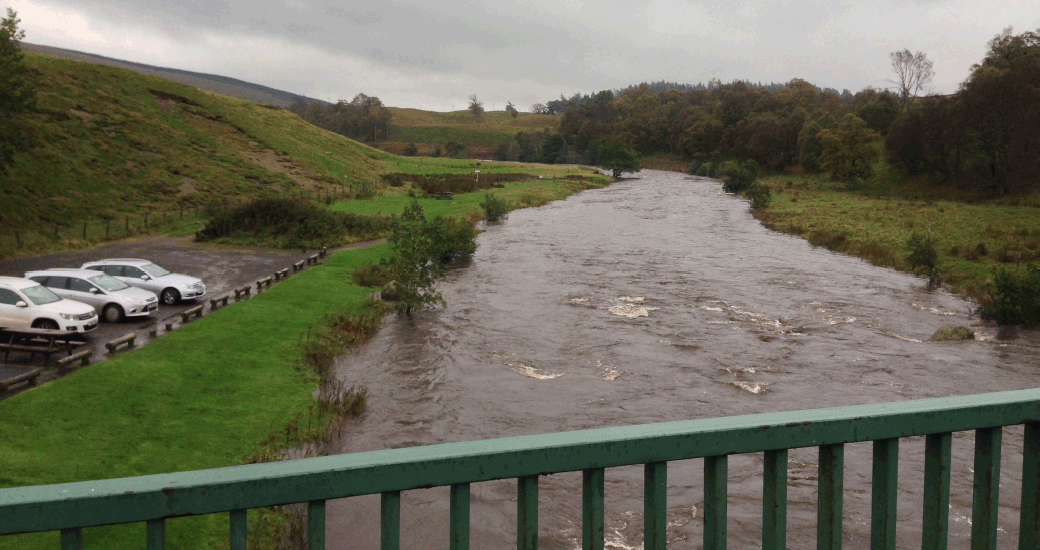
Figure 5.12. Clova Bridge, a potential counter site on River South Esk. This picture shows the river downstream of the bridge. Photo courtesy of InStream Fisheries Research.
Site 2 at the Prosen Bridge is a higher gradient section of the Prosen Water, which is a tributary of the River South Esk ( Figure 5.13 and 5.14). The small channel size makes it an appropriate site for various counter scenarios, although the low conductivity IFR measured during site visit (30 μS) is cause for concern with regards to resistivity counters but is still greater than the threshold value of 20 μS. Year-round measurements of conductivity would have to be conducted if this site was to be assessed further. One major disadvantage of Site 2 is the exposure to the public and associated security risk to equipment. The public can easily access Site 1; this should be a major consideration when making decisions about a site. Site 2 also lacks access to mains power, but given its proximity to power lines, mains power could be easily installed. Access to this site makes batteries a viable option in the absence of mains power.
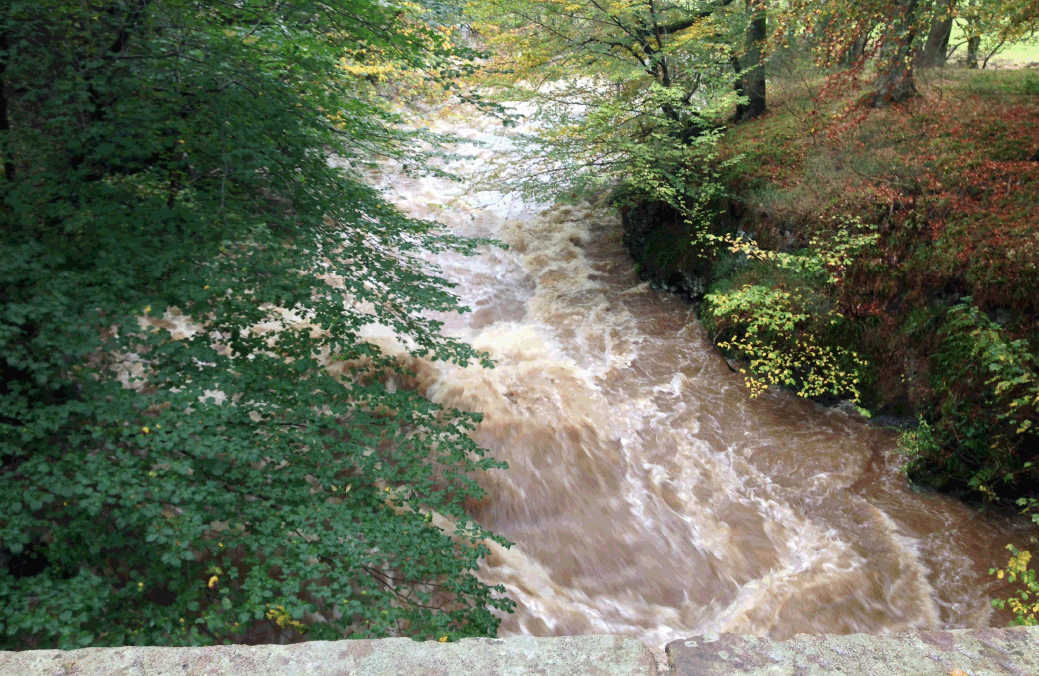
Figure 5.13. Prosen Bridge, a higher gradient section of the Prosen Water, a potential counter site for River South Esk. This picture shows upstream of the bridge. Photo courtesy of InStream Fisheries Research.
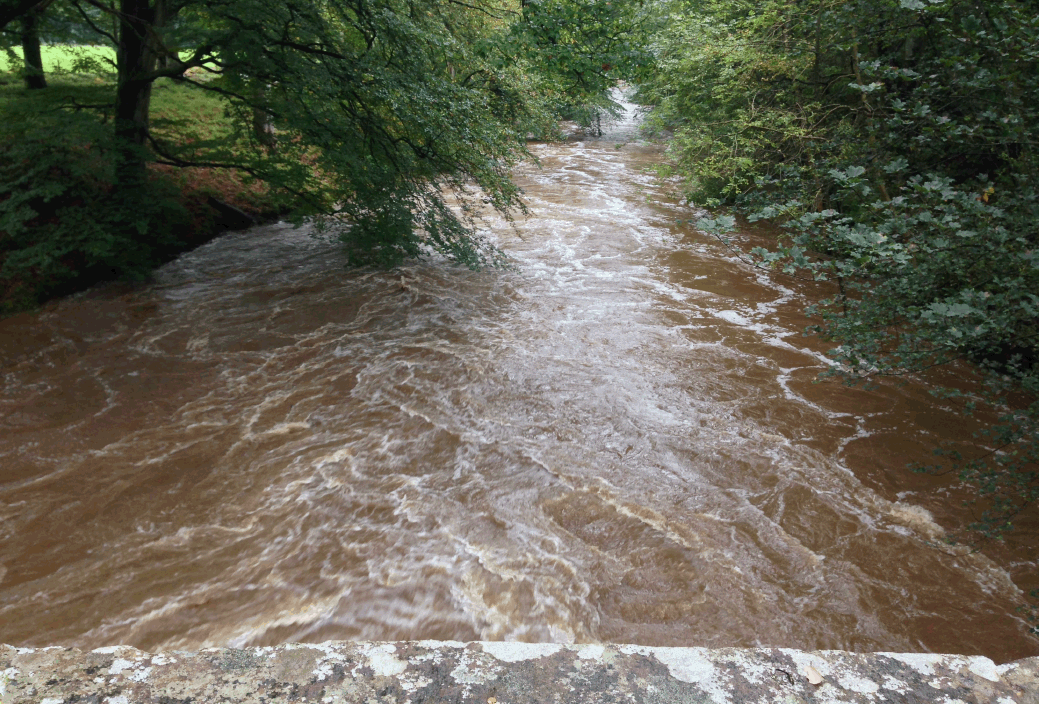
Figure 5.14. Prosen Bridge, a higher gradient section of the Prosen Water. A potential counter site for River South Esk. This picture shows downstream of the bridge. Photo courtesy of InStream Fisheries Research.
Site 4 at the River South Esk weir is a small fish pass in the middle of the fish weir and is a viable counter site ( Figure 5.15). The fish pass provides a controlled environment for fish to pass through and would likely produce highly accurate estimates. Assess is easy, and although the site is accessible to the public, it is not in plain sight. One major advantage of this site is that it is near the lower extent of spawning and a counter in this location would all but a few fish that spawn in the 600 m between the weir and the footbridge downstream. One major disadvantage of this site is that the fish pass is in the middle of the weir and access could be challenging. This is a concern because the South Esk Trust staff indicated that high debris events are common on the river and would likely obstruct the fish pass and counter. In addition, there is no mains power at this site. Access to this site makes batteries a viable option in the absence of mains power.
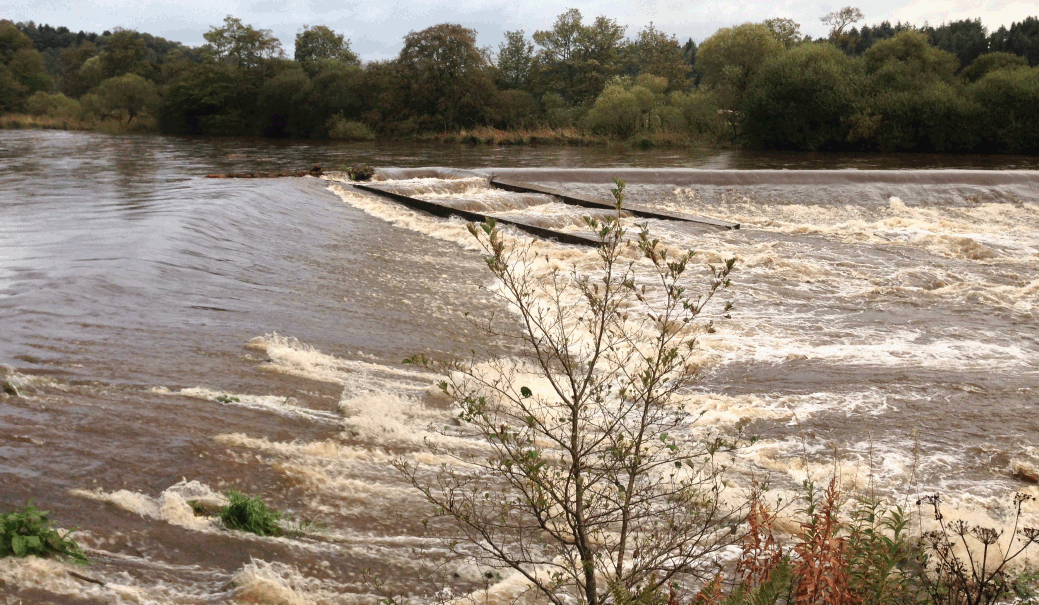
Figure 5.15. South Esk weir, a potential counter site for River South Esk. A small fish pass exists in the middle of the fish weir. Photo courtesy of InStream Fisheries Research.
Site 5 at the footbridge 600 m downstream of the weir is a potential counter site due to its relatively narrow channel, uniform channel shape and low gradient ( Figure 5.16). With the exception of the channel characteristics, the site is similar to Site 3 with regards to good access, high debris potential, and the lack of mains power. This site is below the lower extent of spawning and would enumerate the entire population of salmon. Access to this site makes batteries a viable option in the absence of mains power.
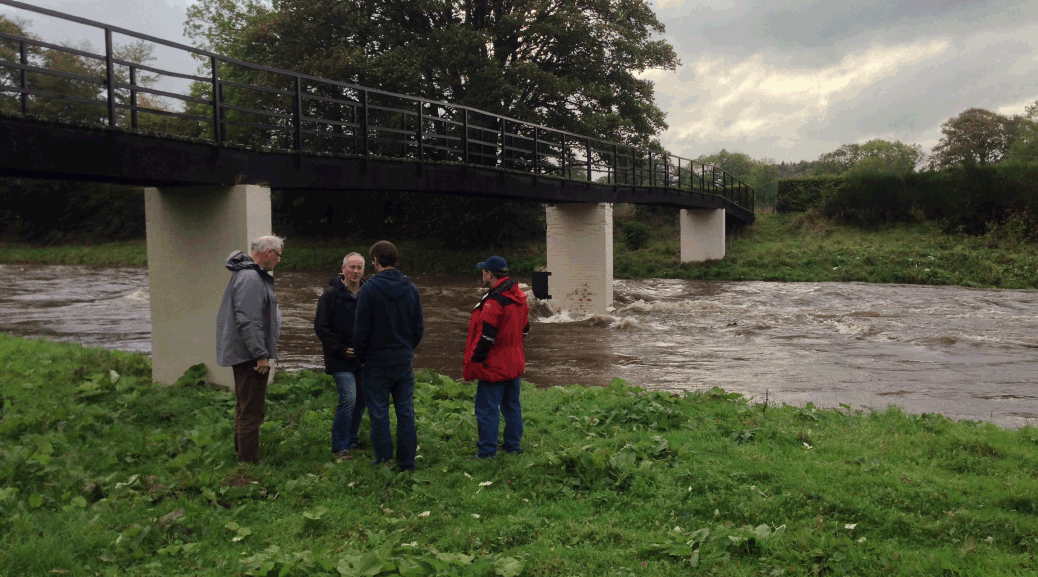
Figure 5.16. South Esk footbridge, a potential counter site for River South Esk. A footbridge downstream of the South Esk weir site. Photo courtesy of InStream Fisheries Research.
Model Output and Counter Evaluation for Sites on River South Esk
Site 1 - Clova Bridge
The decision and cost model retained one technologically and logistically feasible counter scenario out of a possible 184 for the Clova Bridge site on River South Esk ( Table 5.10). High turbidity (> 90 NTU) at Clova Bridge at the time of the IFR site visit removed all counter scenarios where technology = "optical beam". Video counters (technology = "video") were removed as the turbidity at Clova Bridge was > 30 NTU. The channel_type variable removed all counter scenarios where channel_type = "fish pass". Although there is no mains power at the site, mains power is possible and would be the preferred power_type. All counter scenarios with power_type = "battery" were removed. Min_depth removed the majority of the counter options (> 90 cm min_depth required for hydroacoustic counters); this removed all counter options that used hydroacoustic technology.
A resistivity counter with a Crump weir was the only technologically and logistically feasible option, with capital, 10-year operational and 10-year total costs of £327 321, £154 239 and £481 560, respectively ( Table 5.10). While IFR agrees with the model output of a resistivity Crump weir counter setup, coarse site visit data may be the reason for only one feasible counter option at Clova Bridge. A more detailed site assessment that would include monitoring water conditions over time and more accurate depth measurements may reveal additional counter options.
Site 2 - Prosen Bridge
The decision and cost model retained one technologically and logistically feasible counter scenario out of a possible 184 for the Prosen Bridge site on River South Esk ( Table 5.11). High turbidity (> 90 NTU) at Prosen Bridge at the time of the IFR site visit removed all counter scenarios where technology = "optical beam". Video counters (technology = "video") were removed as the turbidity at Prosen Bridge was > 30 NTU. The channel_type variable removed all counter scenarios where channel_type = "fish pass". Prosen Bridge could acquire access to mains power, so all counter scenarios with power_type = "battery" were removed. Min_depth removed the majority of the counter options (> 90 cm min_depth required for hydroacoustic counters); this removed all counter options that used hydroacoustic technology.
A resistivity counter with a Crump weir was the only technologically and logistically feasible option, with capital, 10-year operational and 10-year total costs of £184 106, £154 239 and £338 345, respectively ( Table 5.11). While IFR agrees with the model output of a resistivity Crump weir counter setup, coarse site visit data may be the reason for only one feasible counter option at Prosen Bridge. A more detailed site assessment that would include monitoring water conditions over time and more accurate depth measurements may reveal additional counter options.
Site 4 - Weir
The decision and cost model retained three technologically and logistically feasible counter scenarios out of a possible 184 for Site 4 on River South Esk ( Table 5.12). High turbidity (> 90 NTU) at Site 4 at the time of the IFR site visit removed all counter scenarios where technology = "optical beam". Video counters (technology = "video") were removed as the turbidity at the weir site was > 30 NTU. The channel_type variable removed all counter scenarios where channel_type = "river". The weir site could acquire access to mains power, so all counter scenarios with power_type = "battery" were removed. Min_depth removed the majority of the counter options (> 90 cm min_depth required for hydroacoustic counters); this removed all counter options that used hydroacoustic technology.
Limited Capital Budgets
All three counter scenarios involve resistivity counters with a fish pass insert, with costs varying slightly with the type of resistivity counter (i.e., £10 000 for a Logie 2100C vs. £20 000 for a Mark 12) and sensor type (i.e., tube vs. flume). For budgets limited by capital cost, a Logie 2100C resistivity counter with a fish pass insert and tube sensor had the lowest capital cost of £73 436 (Option 99), followed by a Logie 2100C resistivity counter with a fish pass insert and flume sensor (Option 101, £76 436) and a Mark 12 resistivity counter with a fish pass insert and flume sensor (Option 103, £96 436) ( Table 5.12).
Limited Operational Budgets
All three counter scenarios had the same 10-year operational cost (£158 239) ( Table 5.12). Such a finding highlights the stability of resistivity counters when used in a fish pass and the relatively low cost required to operate a counter setup at a pre-existing fish pass.
The total cost over 10-years (including capital and 10-year operational costs) ranged from £197 300 to £220 300, with Option 103 having a higher cost due to the use of a Mark 12 resistivity counter and flume sensor ( Table 5.12).
Site 5 - Footbridge
The decision and cost model retained one technologically and logistically feasible counter scenario out of a possible 184 for Site 5 on River South Esk (Table 5.13). High turbidity (> 90 NTU) at the footbridge on River South Esk at the time of the IFR site visit removed all counter scenarios where technology = "optical beam". Video counters (technology = "video") were removed as the turbidity at the footbridge was > 30 NTU. The channel_type variable removed all counter scenarios where channel_type = "fish pass". The footbridge site could acquire access to mains power, so all counter scenarios with power_type = "battery" were removed. Min_depth removed the majority of the counter options (< 90 cm threshold required for hydroacoustic counters); this removed all counter options that used hydroacoustic technology.
A resistivity counter with a Crump weir was the only technologically and logistically feasible option, with capital, 10-year operational and 10-year total costs of £411 924, £154 239 and £566 163, respectively ( Table 5.13). While IFR agrees with the model output of a resistivity Crump weir counter setup, coarse site visit data may be the reason for only one feasible counter option at the footbridge site. A more detailed site assessment that would include monitoring water conditions over time and more accurate depth measurements may reveal additional counter options.
Table 5.7. Decision and cost model output for the Clova Bridge site on the River South Esk. Options are ranked by 10-year total cost, from least to most expensive. Costs are provided in GBP, and cost rankings are provided in parentheses. Res. represents resolution.
| Option no. | Technology | Company | Res | Counter | No. counters | Sensor | Structure | Structure pad | Counting software | Capital cost | 10-year operational cost | 10-year total cost |
|---|---|---|---|---|---|---|---|---|---|---|---|---|
| 93 | resistivity | Aquantic | NA | Logie 2100C | 1 | NA | Crump weir | none | automated | 327321 (1) | 154239 (1) | 481560 (1) |
Table 5.8. Decision and cost model output for the Prosen Bridge site on the River South Esk. Options are ranked by 10-year total cost, from least to most expensive. Costs are provided in GBP, and cost rankings are provided in parentheses. Res. represents resolution.
| Option no. | Technology | Company | Res | Counter | No. counters | Sensor | Structure | Structure pad | Counting software | Capital cost | 10-year operational cost | 10-year total cost |
|---|---|---|---|---|---|---|---|---|---|---|---|---|
| 93 | resistivity | Aquantic | NA | Logie 2100C | 1 | NA | Crump weir | none | automated | 184106 (1) | 154239 (1) | 338345 (1) |
Table 5.9. Decision and cost model output for the weir site on the River South Esk. Options are ranked by 10-year total cost, from least to most expensive. Costs are provided in GBP, and cost rankings are provided in parentheses. Res. represents resolution.
| Option no. | Technology | Company | Res. | Counter | No. counters | Sensor | Structure | Structure pad | Counting software | Capital cost | 10-year operational cost | 10-year total cost |
|---|---|---|---|---|---|---|---|---|---|---|---|---|
| 99 | resistivity | Aquantic | NA | Logie 2100C | 1 | tube | fishway insert | none | automated | 39061 (1) | 158239 (1) | 197300 (1) |
| 101 | resistivity | Aquantic | NA | Logie 2100C | 1 | flume | fishway insert | none | automated | 42061 (2) | 158239 (2) | 200300 (2) |
| 103 | resistivity | SSE | NA | Mark 12 | 1 | flume | fishway insert | none | automated | 62061 (3) | 158239 (3) | 220300 (3) |
Table 5.10. Decision and cost model output for the footbridge site on the River South Esk. Options are ranked by 10-year total cost, from least to most expensive. Costs are provided in GBP, and cost rankings are provided in parentheses. Res. represents resolution.
| Option no. | Technology | Company | Res. | Counter | No. counters | Sensor | Structure | Structure pad | Counting software | Capital cost | 10-year operational cost | 10-year total cost |
|---|---|---|---|---|---|---|---|---|---|---|---|---|
| 93 | resistivity | Aquantic | NA | Logie 2100C | 1 | NA | Crump weir | none | automated | 411924 (1) | 154239 (1) | 566163 (1) |
5.3.5 River Lochy
Watershed and Site Characteristics
River Lochy is a medium-sized river; it has a catchment area of 1252 km 2 and a discharge of 32 m 3s -1 (6-149 m 3s -1) measured at the Camisky NRFA station (No. 91002) ( Figure 5.17). Discharge data from Camisky is applicable to the two potential counter sites visited by IFR staff.
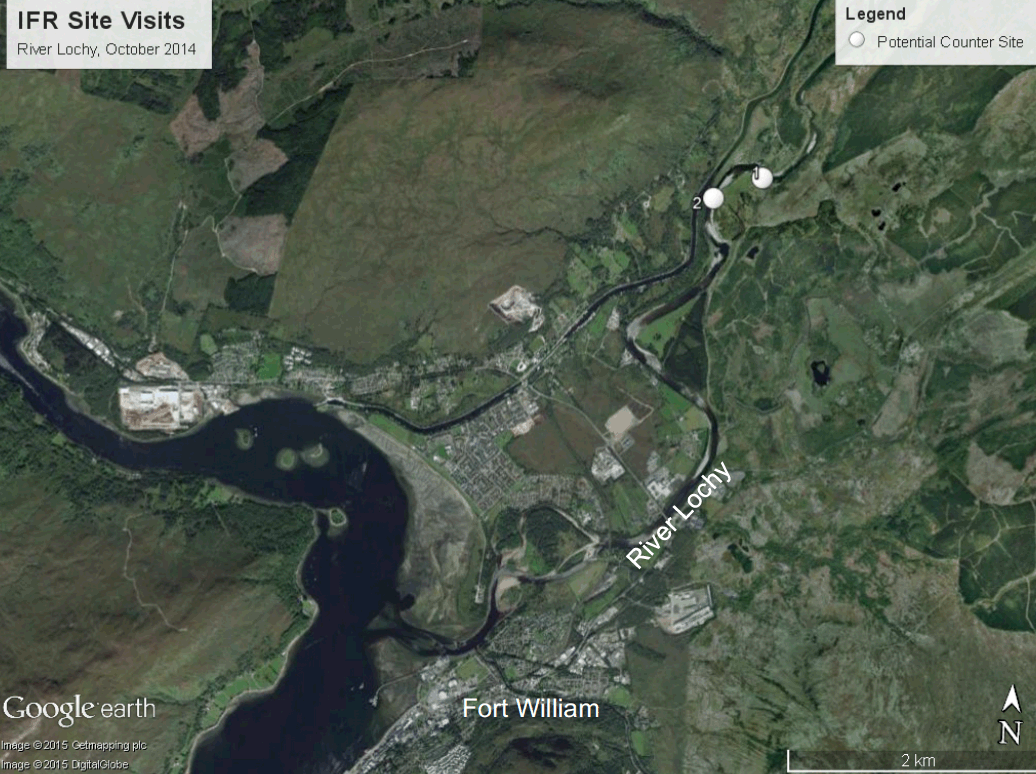
Figure 5.17. Potential counter sites visited by IFR on River Lochy.
Species and Run Timing
River Lochy supports salmon and trout, which have overlapping size distributions and run timing (spring to fall). Notably, some fish migrate during the winter and early spring. Spring migrations of salmon in River Lochy are uncommon. Historically, the spawning salmon abundances were between 2000 and 10 000 fish, but sea trout abundances are unknown. Sea trout are generally smaller than grilse, but co-migrate from May to September.
IFR Site Visit
IFR staff visited two potential sites on River Lochy with River Lochy staff - the gorge (Site 1) and the canal pool (Site 2). Site 1 is a deep narrow bedrock section of the river that would likely cause fish to exhibit milling behaviour, potentially causing double counting and thus affecting the accuracy of abundance estimates. IFR did not run the model because a counter previously placed at this site was deemed to perform poorly.
Site 2 is a low gradient glide that was highly suitable for a counter setup due to channel morphology, anticipated fish migration behaviour, and access. Channel morphology was deepest on river right and shallow on river left - this triangular-shaped channel is ideal for operating hydroacoustic counters and a diversion fence ( Figure 5.18). With this triangular morphology, increases in river discharge result in comparatively smaller increases in stage height than in a confined channel. Furthermore, the channel would be wadeable at higher discharges making a diversion fence a possible approach. A second main advantage of this site was access. IFR was able to drive directly to the site and access it along a property owner's road, reducing the time and challenges associated with carrying gear into the site. Of course this is especially true if there is no mains power and batteries are required. The location is also on private property, which would provide adequate security. Finally, Lochaber Fisheries Trust staff indicated that fish continually migrate through this section of the river and holding would be minimal. Notably, the main challenge with this site is the lack of mains power. Mains power, however, could be established at this site as it is located on a property and power is nearby. Access to this site makes batteries a viable option in the absence of mains power.
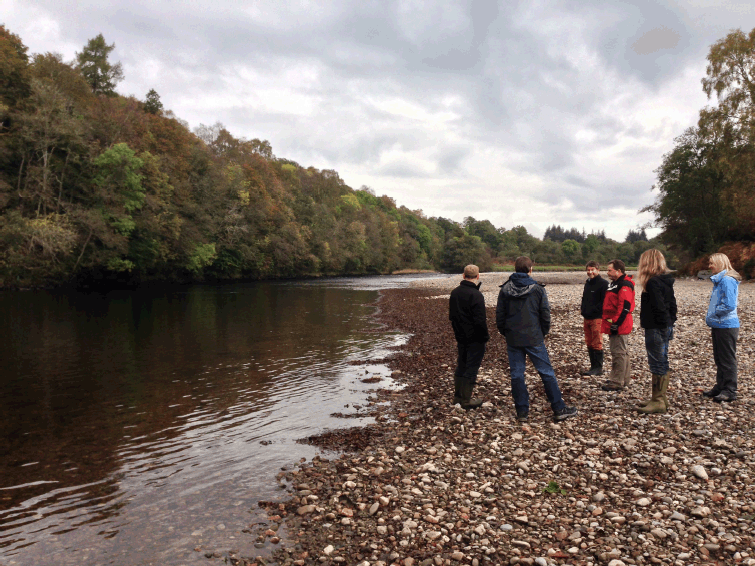
Figure 5.18. River Lochy canal pool, a potential counter site for River Lochy. Photo courtesy of InStream Fisheries Research.
Model Output and Counter Evaluation for River Lochy - Canal Pool
The decision and cost model retained 52 technologically and logistically feasible counter scenarios out of a possible 184 for the canal pool site on River Lochy ( Table 5.14). The channel_type variable removed all counter scenarios where channel_type = "fish pass". Although there is no mains power at the site, mains power is possible and would be the preferred power_type so all counter scenarios with power_type = "battery" were removed. Max_depth was greater than 100 cm threshold, removing options for flat pad sensors.
Limited Capital Budgets
The five least expensive options include only video and hydroacoustic counters, varying in the types of structures (scenarios with or without fences). Video counter scenarios offer the least expensive capital costs starting at £45 270, followed by scenarios ranked 2 through 5 using multibeam hydroacoustic counters ranging from £62 337 to £85 436 (Table 5.14). Capital cost increased steadily through to the 31 st ranked scenario (cost of £195 595), but increased to £572 993 for the 32 nd ranked scenario. This major increase in cost was due to the inclusion of a permanent "concrete sill" for the fence instead of a removable "chain ballast" structure_pad.
Limited Operational Budgets
The five least expensive options over a 10-year operational period include optical beam and hydroacoustic counters. Counter scenarios ranked 1 through 4 use optical beam counters and have a 4.7-fold lower operational cost than the 5 th ranked counter scenario that uses a multibeam hydroacoustic counter (Table 5.14). We do not recommend, however, using the optical beam counters because of the large risk associated with operating such a large fence that would be required for an optical beam counter (e.g., Vaki Riverwatcher). All counter scenarios that use hydroacoustic counters have similar operational costs ranging from £660 150 to £681 150 when Echoview counting software is used, but 10-year operational costs increased to £1 834 150 when Echoview is not used.
The 10-year total costs show similar results to the 10-year operational costs, with the counter scenarios ranked 1 and 2 using optical beam counters and scenarios ranked 3 through 5 using multibeam hydroacoustic counters (Table 5.14). There was a marked difference in total cost between counter scenarios using these two counter types, whereby optical beam counters (ranked 1 and 2 with total 10-year costs of £236 607 and £263 607, respectively) were 2.8-fold less expensive than scenarios using hydroacoustic counters (ranked 3, 4, and 5 with total 10-year costs of £741 377, £748 476, and £749 074, respectively). Considering the costs and IFR's professional experience, we recommend using a single hydroacoustic counter with a fence structure and Echoview software for the operation of Site 2 - the canal pool on River Lochy.
Table 5.11. Decision and cost model output for the canal pool site on the River Lochy. Options are ranked by 10-year total cost, from least to most expensive. Costs are provided in GBP, and cost rankings are provided in parentheses. Res. represents resolution.
| Option | Technology | Company | Settings | Counter | No. counters | Sensor | Structure | Structure pad | Counting software | Capital cost | 10-year operational cost | 10-year total cost |
|---|---|---|---|---|---|---|---|---|---|---|---|---|
| 108 | optical beam | Vaki | NA | Riverwatcher | 1 | NA | floating fence | chain ballast | automated | 88993 (8) | 147614 (1) | 236607 (1) |
| 116 | optical beam | Vaki | NA | Riverwatcher | 2 | NA | floating fence | chain ballast | automated | 115993 (22) | 147614 (2) | 263607 (2) |
| 32 | hydroacoustic | Teledyne BlueView | low | BlueView | 1 | NA | floating fence | chain ballast | Echoview | 89727 (11) | 662150 (6) | 741377 (3) |
| 40 | hydroacoustic | Teledyne BlueView | high | BlueView | 1 | NA | floating fence | chain ballast | Echoview | 96826 (14) | 662150 (7) | 748476 (4) |
| 45 | hydroacoustic | Teledyne BlueView | low | BlueView | 2 | NA | none | none | Echoview | 100424 (15) | 660150 (5) | 749074 (5) |
| 48 | hydroacoustic | Teledyne BlueView | low | BlueView | 2 | NA | floating fence | chain ballast | Echoview | 102424 (19) | 662150 (8) | 753074 (6) |
| 46 | hydroacoustic | Teledyne BlueView | low | BlueView | 2 | NA | picket fence | none | Echoview | 100424 (16) | 671150 (19) | 760074 (7) |
| 13 | hydroacoustic | BioSonics | low | D-TX | 1 | NA | none | none | Echoview | 102037 (17) | 670150 (18) | 761237 (8) |
| 107 | optical beam | Vaki | NA | Riverwatcher | 1 | NA | floating fence | concrete sill | automated | 616716 (35) | 147614 (3) | 764330 (9) |
| 16 | hydroacoustic | BioSonics | low | D-TX | 1 | NA | floating fence | chain ballast | Echoview | 104037 (20) | 672150 (20) | 765237 (10) |
| 4 | video | various | NA | various | 1 | NA | floating fence | chain ballast | none | 45270 (1) | 721864 (27) | 766234 (11) |
| 56 | hydroacoustic | Teledyne BlueView | high | BlueView | 2 | NA | floating fence | chain ballast | Echoview | 119072 (23) | 662150 (9) | 769722 (12) |
| 14 | hydroacoustic | BioSonics | low | D-TX | 1 | NA | picket fence | none | Echoview | 102037 (18) | 681150 (26) | 772237 (13) |
| 115 | optical beam | Vaki | NA | Riverwatcher | 2 | NA | floating fence | concrete sill | automated | 643716 (43) | 147614 (4) | 791330 (14) |
| 124 | hydroacoustic | Sound Metrics | low | DIDSON 300 | 1 | NA | floating fence | chain ballast | Echoview | 144688 (26) | 667150 (14) | 801338 (15) |
| 132 | hydroacoustic | Sound Metrics | high | DIDSON 300 | 1 | NA | floating fence | chain ballast | Echoview | 149049 (27) | 667150 (15) | 805699 (16) |
| 140 | hydroacoustic | Sound Metrics | low | DIDSON 300 | 2 | NA | floating fence | chain ballast | Echoview | 186873 (30) | 672150 (21) | 847523 (17) |
| 148 | hydroacoustic | Sound Metrics | high | DIDSON 300 | 2 | NA | floating fence | chain ballast | Echoview | 195595 (31) | 672150 (22) | 856245 (18) |
| 31 | hydroacoustic | Teledyne BlueView | low | BlueView | 1 | NA | floating fence | concrete sill | Echoview | 617450 (36) | 662150 (10) | 1269100 (19) |
| 39 | hydroacoustic | Teledyne BlueView | high | BlueView | 1 | NA | floating fence | concrete sill | Echoview | 624549 (39) | 662150 (11) | 1276199 (20) |
| 47 | hydroacoustic | Teledyne BlueView | low | BlueView | 2 | NA | floating fence | concrete sill | Echoview | 630147 (40) | 662150 (12) | 1280797 (21) |
| 15 | hydroacoustic | BioSonics | low | D-TX | 1 | NA | floating fence | concrete sill | Echoview | 631760 (41) | 672150 (23) | 1292960 (22) |
| 3 | video | various | NA | various | 1 | NA | floating fence | concrete sill | none | 572993 (32) | 721864 (28) | 1293957 (23) |
| 55 | hydroacoustic | Teledyne BlueView | high | BlueView | 2 | NA | floating fence | concrete sill | Echoview | 646795 (44) | 662150 (13) | 1297445 (24) |
| 123 | hydroacoustic | Sound Metrics | low | DIDSON 300 | 1 | NA | floating fence | concrete sill | Echoview | 672411 (47) | 667150 (16) | 1329061 (25) |
| 131 | hydroacoustic | Sound Metrics | high | DIDSON 300 | 1 | NA | floating fence | concrete sill | Echoview | 676772 (48) | 667150 (17) | 1333422 (26) |
| 139 | hydroacoustic | Sound Metrics | low | DIDSON 300 | 2 | NA | floating fence | concrete sill | Echoview | 714596 (51) | 672150 (24) | 1375246 (27) |
| 147 | hydroacoustic | Sound Metrics | high | DIDSON 300 | 2 | NA | floating fence | concrete sill | Echoview | 723318 (52) | 672150 (25) | 1383968 (28) |
| 69 | hydroacoustic | Teledyne BlueView | high | BlueView | 1 | NA | none | none | none | 62337 (2) | 1834150 (29) | 1885987 (29) |
| 64 | hydroacoustic | Teledyne BlueView | low | BlueView | 1 | NA | floating fence | chain ballast | none | 77247 (4) | 1836150 (31) | 1902897 (30) |
| 70 | hydroacoustic | Teledyne BlueView | high | BlueView | 1 | NA | picket fence | none | none | 73557 (3) | 1845150 (44) | 1908207 (31) |
| 77 | hydroacoustic | Teledyne BlueView | low | BlueView | 2 | NA | none | none | none | 87944 (6) | 1834150 (30) | 1910594 (32) |
| 72 | hydroacoustic | Teledyne BlueView | high | BlueView | 1 | NA | floating fence | chain ballast | none | 85346 (5) | 1836150 (32) | 1910996 (33) |
| 80 | hydroacoustic | Teledyne BlueView | low | BlueView | 2 | NA | floating fence | chain ballast | none | 89944 (12) | 1836150 (33) | 1914594 (34) |
| 78 | hydroacoustic | Teledyne BlueView | low | BlueView | 2 | NA | picket fence | none | none | 87944 (7) | 1845150 (45) | 1921594 (35) |
| 21 | hydroacoustic | BioSonics | low | D-TX | 1 | NA | none | none | none | 89557 (9) | 1844150 (43) | 1922757 (36) |
| 24 | hydroacoustic | BioSonics | low | D-TX | 1 | NA | floating fence | chain ballast | none | 91557 (13) | 1846150 (46) | 1926757 (37) |
| 88 | hydroacoustic | Teledyne BlueView | high | BlueView | 2 | NA | floating fence | chain ballast | none | 106592 (21) | 1836150 (34) | 1931242 (38) |
| 22 | hydroacoustic | BioSonics | low | D-TX | 1 | NA | picket fence | none | none | 89557 (10) | 1855150 (52) | 1933757 (39) |
| 156 | hydroacoustic | Sound Metrics | low | DIDSON 300 | 1 | NA | floating fence | chain ballast | none | 132208 (24) | 1841150 (39) | 1962858 (40) |
| 164 | hydroacoustic | Sound Metrics | high | DIDSON 300 | 1 | NA | floating fence | chain ballast | none | 136569 (25) | 1841150 (40) | 1967219 (41) |
| 172 | hydroacoustic | Sound Metrics | low | DIDSON 300 | 2 | NA | floating fence | chain ballast | none | 174393 (28) | 1846150 (47) | 2009043 (42) |
| 180 | hydroacoustic | Sound Metrics | high | DIDSON 300 | 2 | NA | floating fence | chain ballast | none | 183115 (29) | 1846150 (48) | 2017765 (43) |
| 63 | hydroacoustic | Teledyne BlueView | low | BlueView | 1 | NA | floating fence | concrete sill | none | 604970 (33) | 1836150 (35) | 2430620 (44) |
| 71 | hydroacoustic | Teledyne BlueView | high | BlueView | 1 | NA | floating fence | concrete sill | none | 613069 (34) | 1836150 (36) | 2438719 (45) |
| 79 | hydroacoustic | Teledyne BlueView | low | BlueView | 2 | NA | floating fence | concrete sill | none | 617667 (37) | 1836150 (37) | 2442317 (46) |
| 23 | hydroacoustic | BioSonics | low | D-TX | 1 | NA | floating fence | concrete sill | none | 619280 (38) | 1846150 (49) | 2454480 (47) |
| 87 | hydroacoustic | Teledyne BlueView | high | BlueView | 2 | NA | floating fence | concrete sill | none | 634315 (42) | 1836150 (38) | 2458965 (48) |
| 155 | hydroacoustic | Sound Metrics | low | DIDSON 300 | 1 | NA | floating fence | concrete sill | none | 659931 (45) | 1841150 (41) | 2490581 (49) |
| 163 | hydroacoustic | Sound Metrics | high | DIDSON 300 | 1 | NA | floating fence | concrete sill | none | 664292 (46) | 1841150 (42) | 2494942 (50) |
| 171 | hydroacoustic | Sound Metrics | low | DIDSON 300 | 2 | NA | floating fence | concrete sill | none | 702116 (49) | 1846150 (50) | 2536766 (51) |
| 179 | hydroacoustic | Sound Metrics | high | DIDSON 300 | 2 | NA | floating fence | concrete sill | none | 710838 (50) | 1846150 (51) | 2545488 (52) |
5.3.6 River Dee
Watershed and Site Characteristics
River Dee at the Woodend NRFA station (No. 12001) has a catchment area of 1370 km 2 and a discharge of 27 m 3s -1 (8-74 m 3s -1) ( Figure 5.19). Discharge data from the Woodend gauge station is applicable to the potential counter site visited by IFR staff.
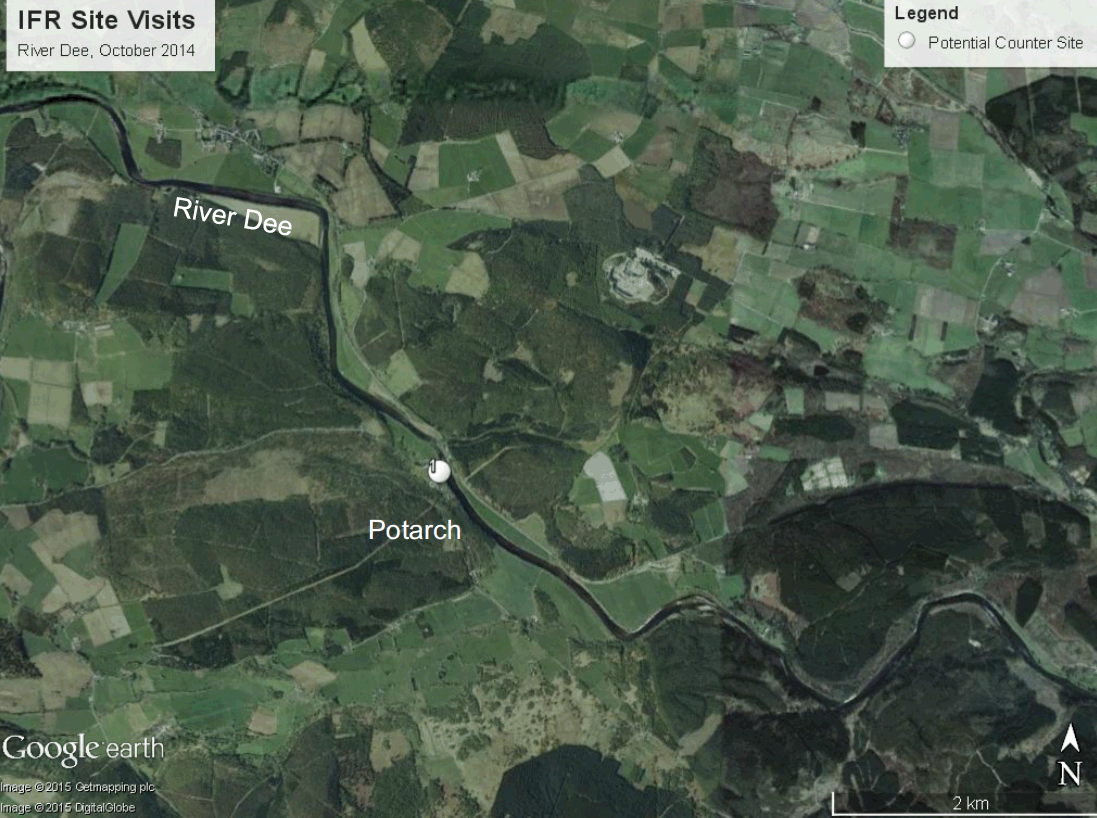
Figure 5.19. Potential counter site visited by IFR on River Dee.
Species and Run Timing
River Dee supports a significant proportion of salmon in Scotland, where 3570 fish were caught by rod and reel in 2014 (River Dee Trust 2014). River Dee also supports large populations of trout (sea trout rod catch of approximately 1 500 fish in 2014), which have overlapping size distributions and run timing (spring to fall) with salmon. Spring runs of salmon are of specific interest. The River Dee is designated as a SAC for salmon runs.
IFR Site Visit
IFR staff visited one potential site on River Dee with Dee District Salmon Fishery Board staff - downstream of the Potarch Bridge. Though this site has potential as a counter site, its large channel width makes it difficult for technologies other than hydroacoustic counters ( Figure 5.20). The site is low gradient and can be deep in some areas. Large debris flows are possible during high discharge events that would make operating a diversion fence risky. The triangular shape of the channel makes it suitable for hydroacoustic counters. One disadvantage of the site is the exposure to the public and the associated security risk to equipment. Public can easily access the site; this should be a major consideration when making decisions about a site. Notably, the site also lacks access to mains power, but given its proximity to existing power lines, mains power could be easily installed.
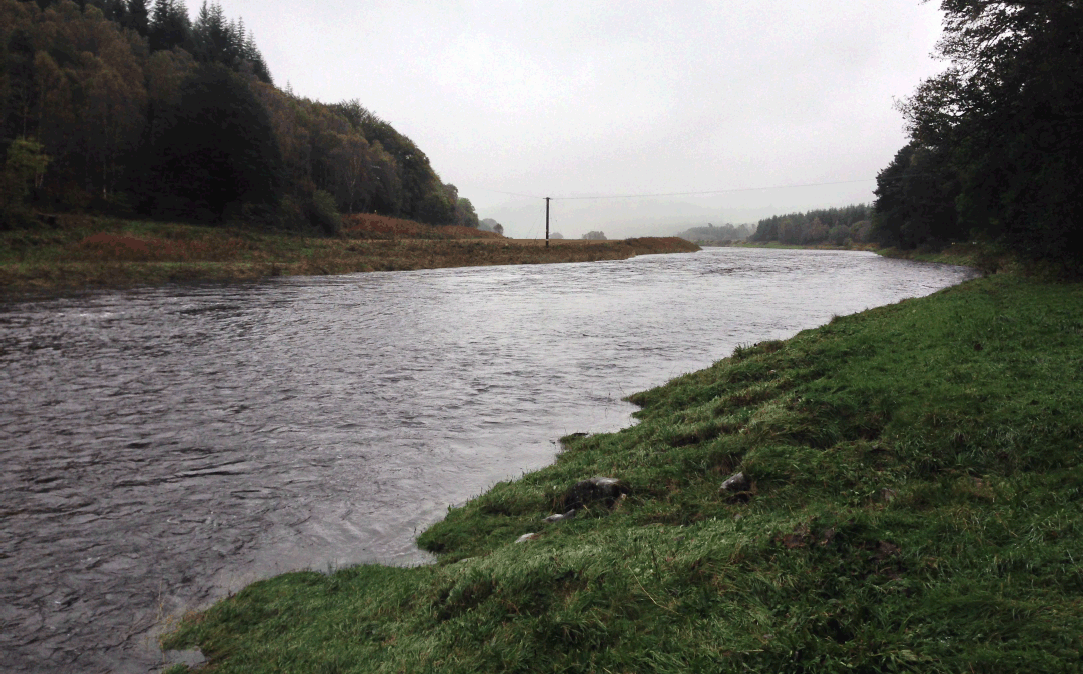
Figure 5.20. River Dee at Portarch Bridge, a potential counter site for River Dee. Photo courtesy of InStream Fisheries Research.
Model Output and Counter Evaluation for River Dee
The decision and cost model retained 44 technologically and logistically feasible scenarios out of a possible 184 for the Potarch Bridge site on River Dee (Table 5.15). The channel_type variable removed all counter scenarios where the channel_type = "fish pass". Although, there is no mains power at the site, mains power is possible and would be the preferred power_type so all counter scenarios with power_type = "battery" were removed. Other variables that removed other counter options were max_depth > 100 cm and wadeable = "no", which removed flat pad counters and picket fences, respectively. Finally, maximum_ww = 50 removed the counter scenarios that involved resistivity counters, as the max width per sensor or channel is limited to 8 m.
Limited Capital Budgets
The five least expensive options include video and hydroacoustic counters, varying in the types of structures and sensor units. Video counter scenarios offer the least expensive capital costs starting at £51 500 (Table 5.15). Although this option is deemed suitable by the model, we do not recommend using video in this location, as the technology is susceptible to environmental changes and the logistics and risks of installing a fence that spans the width of the site (50 m). Counter scenarios ranked 2 through 4 include both single multibeam and single splitbeam hydroacoustic counters, and ranged from £83 477 to £91 576 in capital costs. The capital costs of other hydroacoustic options increase substantially due to the use of permanent structure pads (e.g., concrete sill) for securing fences instead of using a removable structure pad (e.g., chain ballast). Costs increased from a maximum of £201 825 when using a chain ballast or no structure pad to a minimum of £846 890 when using a concrete sill structure pad.
Limited Operational Budgets
The five least expensive options over a 10-year operational period include optical beam and hydroacoustic counters. The top four ranked counter scenarios used optical beam counters, while the 5 th ranked option used a multibeam hydroacoustic counter (Table 5.15). Optical beam counters automate fish counting and have built-in video validation capabilities, which leads to a low operational cost of £141 364 over 10 years. The 10-year operational cost of the 5 th ranked counter scenario that used a hydroacoustic counter and included Echoview counting software increased to £653 483. The amount of time required for data post-processing and the cost of third party software attributed to the high cost of operating a hydroacoustic counter over a 10-year period. All counter scenarios that used hydroacoustic counters have similar operational costs, ranging from £653 483 to £663 483 when Echoview counting software is used. 10-year operational costs increase to £1 836 150 when Echoview is not used.
The 10-year total costs show similar results to the 10-year operational costs, with counter scenarios ranked 1 and 2 using optical beam counters and scenarios ranked 3 through 5 using multibeam hydroacoustic counters. There was a marked difference in total cost between counter scenarios using these two counter types, whereby optical beam counters (ranked 1 and 2 with total 10-year costs of £236 587 and £263 587, respectively) were 2.7-fold less expensive than scenarios using hydroacoustic counters (ranked 3, 4, and 5 with total 10-year costs of £746 039, £751 087 and £752 570, respectively) (Table 5.15). Considering the costs and IFR's professional experience, we recommend using a single hydroacoustic counter with a fence structure and Echoview software for the operation of Site 1 - Potarch Bridge on the River Dee.
Table 5.12. Decision and cost model output for the Potarch Bridge site on the River Dee. Options are ranked by 10-year total cost, from least to most expensive. Costs are provided in GBP, and cost rankings are provided in parentheses. Res. represents resolution.
| Option no. | Technology | Company | Res. | Counter | No. counters | Sensor | Structure | Structure pad | Counting software | Capital cost | 10-year operational cost | 10-year total cost |
|---|---|---|---|---|---|---|---|---|---|---|---|---|
| 108 | optical beam | Vaki | NA | Riverwatcher | 1 | NA | floating fence | chain ballast | automated | 95223 (6) | 141364 (1) | 236587 (1) |
| 116 | optical beam | Vaki | NA | Riverwatcher | 2 | NA | floating fence | chain ballast | automated | 122223 (14) | 141364 (2) | 263587 (2) |
| 32 | hydroacoustic | Teledyne BlueView | low | BlueView | 1 | NA | floating fence | chain ballast | Echoview | 95957 (7) | 653483 (5) | 738940 (3) |
| 40 | hydroacoustic | Teledyne BlueView | high | BlueView | 1 | NA | floating fence | chain ballast | Echoview | 103056 (10) | 653483 (6) | 746039 (4) |
| 48 | hydroacoustic | Teledyne BlueView | low | BlueView | 2 | NA | floating fence | chain ballast | Echoview | 109104 (12) | 653483 (7) | 751087 (5) |
| 13 | hydroacoustic | BioSonics | low | D-TX | 1 | NA | none | none | Echoview | 102037 (9) | 661483 (17) | 752570 (6) |
| 16 | hydroacoustic | BioSonics | low | D-TX | 1 | NA | floating fence | chain ballast | Echoview | 104037 (11) | 663483 (18) | 756570 (7) |
| 56 | hydroacoustic | Teledyne BlueView | high | BlueView | 2 | NA | floating fence | chain ballast | Echoview | 125302 (15) | 653483 (8) | 767285 (8) |
| 4 | video | various | NA | various | 1 | NA | floating fence | chain ballast | none | 51500 (1) | 721864 (24) | 772464 (9) |
| 124 | hydroacoustic | Sound Metrics | low | DIDSON 300 | 1 | NA | floating fence | chain ballast | Echoview | 150918 (18) | 658483 (13) | 798901 (10) |
| 132 | hydroacoustic | Sound Metrics | high | DIDSON 300 | 1 | NA | floating fence | chain ballast | Echoview | 155279 (19) | 658483 (14) | 803262 (11) |
| 140 | hydroacoustic | Sound Metrics | low | DIDSON 300 | 2 | NA | floating fence | chain ballast | Echoview | 193103 (22) | 663483 (19) | 845086 (12) |
| 148 | hydroacoustic | Sound Metrics | high | DIDSON 300 | 2 | NA | floating fence | chain ballast | Echoview | 201825 (23) | 663483 (20) | 853808 (13) |
| 107 | optical beam | Vaki | NA | Riverwatcher | 1 | NA | floating fence | concrete sill | automated | 890613 (28) | 141364 (3) | 1031977 (14) |
| 115 | optical beam | Vaki | NA | Riverwatcher | 2 | NA | floating fence | concrete sill | automated | 917613 (35) | 141364 (4) | 1058977 (15) |
| 31 | hydroacoustic | Teledyne BlueView | low | BlueView | 1 | NA | floating fence | concrete sill | Echoview | 891347 (29) | 653483 (9) | 1534330 (16) |
| 39 | hydroacoustic | Teledyne BlueView | high | BlueView | 1 | NA | floating fence | concrete sill | Echoview | 898446 (31) | 653483 (10) | 1541429 (17) |
| 47 | hydroacoustic | Teledyne BlueView | low | BlueView | 2 | NA | floating fence | concrete sill | Echoview | 904494 (33) | 653483 (11) | 1546477 (18) |
| 15 | hydroacoustic | BioSonics | low | D-TX | 1 | NA | floating fence | concrete sill | Echoview | 899427 (32) | 663483 (21) | 1551960 (19) |
| 55 | hydroacoustic | Teledyne BlueView | high | BlueView | 2 | NA | floating fence | concrete sill | Echoview | 920692 (36) | 653483 (12) | 1562675 (20) |
| 3 | video | various | NA | various | 1 | NA | floating fence | concrete sill | none | 846890 (24) | 721864 (25) | 1567854 (21) |
| 123 | hydroacoustic | Sound Metrics | low | DIDSON 300 | 1 | NA | floating fence | concrete sill | Echoview | 946308 (39) | 658483 (15) | 1594291 (22) |
| 131 | hydroacoustic | Sound Metrics | high | DIDSON 300 | 1 | NA | floating fence | concrete sill | Echoview | 950669 (40) | 658483 (16) | 1598652 (23) |
| 139 | hydroacoustic | Sound Metrics | low | DIDSON 300 | 2 | NA | floating fence | concrete sill | Echoview | 988493 (43) | 663483 (22) | 1640476 (24) |
| 147 | hydroacoustic | Sound Metrics | high | DIDSON 300 | 2 | NA | floating fence | concrete sill | Echoview | 997215 (44) | 663483 (23) | 1649198 (25) |
| 64 | hydroacoustic | Teledyne BlueView | low | BlueView | 1 | NA | floating fence | chain ballast | none | 83477 (2) | 1836150 (26) | 1909127 (26) |
| 72 | hydroacoustic | Teledyne BlueView | high | BlueView | 1 | NA | floating fence | chain ballast | none | 91576 (5) | 1836150 (27) | 1917226 (27) |
| 80 | hydroacoustic | Teledyne BlueView | low | BlueView | 2 | NA | floating fence | chain ballast | none | 96624 (8) | 1836150 (28) | 1921274 (28) |
| 21 | hydroacoustic | BioSonics | low | D-TX | 1 | NA | none | none | none | 89557 (3) | 1844150 (38) | 1922757 (29) |
| 24 | hydroacoustic | BioSonics | low | D-TX | 1 | NA | floating fence | chain ballast | none | 91557 (4) | 1846150 (39) | 1926757 (30) |
| 88 | hydroacoustic | Teledyne BlueView | high | BlueView | 2 | NA | floating fence | chain ballast | none | 112822 (13) | 1836150 (29) | 1937472 (31) |
| 156 | hydroacoustic | Sound Metrics | low | DIDSON 300 | 1 | NA | floating fence | chain ballast | none | 138438 (16) | 1841150 (34) | 1969088 (32) |
| 164 | hydroacoustic | Sound Metrics | high | DIDSON 300 | 1 | NA | floating fence | chain ballast | none | 142799 (17) | 1841150 (35) | 1973449 (33) |
| 172 | hydroacoustic | Sound Metrics | low | DIDSON 300 | 2 | NA | floating fence | chain ballast | none | 180623 (20) | 1846150 (40) | 2015273 (34) |
| 180 | hydroacoustic | Sound Metrics | high | DIDSON 300 | 2 | NA | floating fence | chain ballast | none | 189345 (21) | 1846150 (41) | 2023995 (35) |
| 63 | hydroacoustic | Teledyne BlueView | low | BlueView | 1 | NA | floating fence | concrete sill | none | 878867 (25) | 1836150 (30) | 2704517 (36) |
| 71 | hydroacoustic | Teledyne BlueView | high | BlueView | 1 | NA | floating fence | concrete sill | none | 886966 (27) | 1836150 (31) | 2712616 (37) |
| 79 | hydroacoustic | Teledyne BlueView | low | BlueView | 2 | NA | floating fence | concrete sill | none | 892014 (30) | 1836150 (32) | 2716664 (38) |
| 23 | hydroacoustic | BioSonics | low | D-TX | 1 | NA | floating fence | concrete sill | none | 886947 (26) | 1846150 (42) | 2722147 (39) |
| 87 | hydroacoustic | Teledyne BlueView | high | BlueView | 2 | NA | floating fence | concrete sill | none | 908212 (34) | 1836150 (33) | 2732862 (40) |
| 155 | hydroacoustic | Sound Metrics | low | DIDSON 300 | 1 | NA | floating fence | concrete sill | none | 933828 (37) | 1841150 (36) | 2764478 (41) |
| 163 | hydroacoustic | Sound Metrics | high | DIDSON 300 | 1 | NA | floating fence | concrete sill | none | 938189 (38) | 1841150 (37) | 2768839 (42) |
| 171 | hydroacoustic | Sound Metrics | low | DIDSON 300 | 2 | NA | floating fence | concrete sill | none | 976013 (41) | 1846150 (43) | 2810663 (43) |
| 179 | hydroacoustic | Sound Metrics | high | DIDSON 300 | 2 | NA | floating fence | concrete sill | none | 984735 (42) | 1846150 (44) | 2819385 (44) |
5.3.7 River Polla
Watershed and Site Characteristics
River Polla is a small river in northern Scotland ( Figure 5.21). Currently there are no NRFA gauging stations on River Polla.
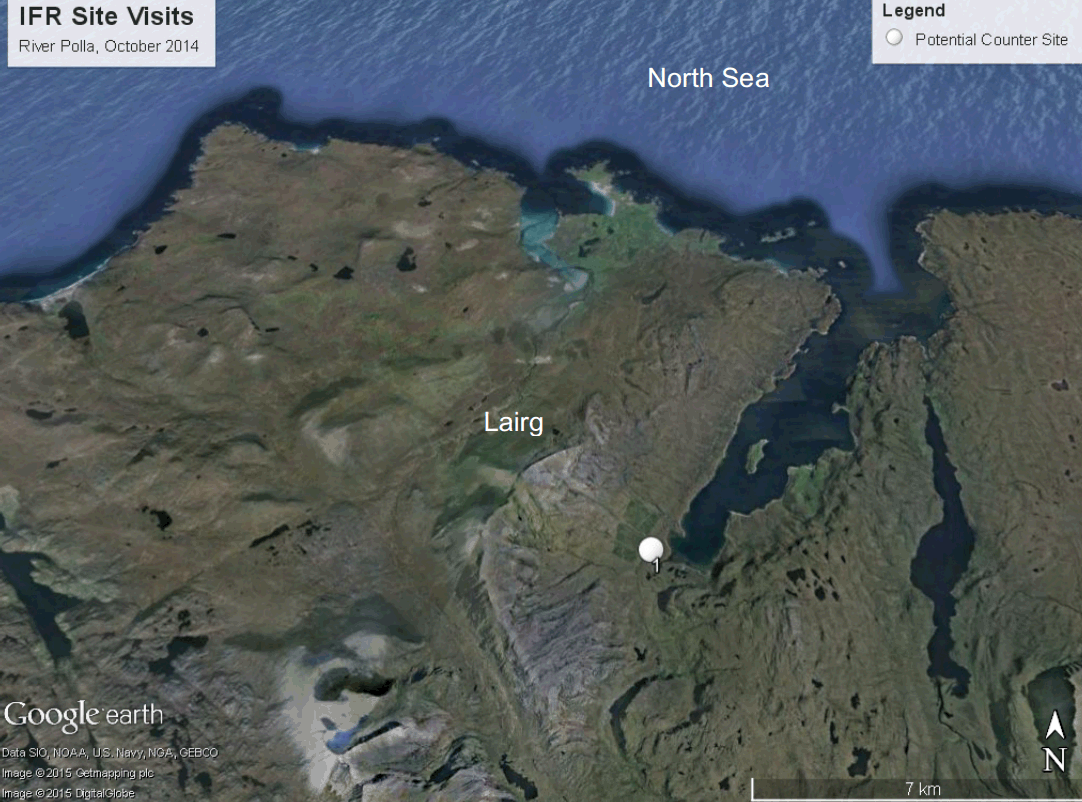
Figure 5.21. Potential counter site visited by IFR on River Polla.
Species and Run Timing
River Polla supports both salmon and trout (majority of the fish being sea trout), which do not have overlapping size distributions but do have overlapping run timing (summer to fall). Most of the salmon are grilse but some multi-sea-winter fish are present. Typical grilse salmon and sea trout rod catches for the River Polla are around 70 and 100+ individuals, respectively.
IFR Site Visit
IFR staff visited one potential site on River Polla upstream of the stone bridge near the ocean confluence ( Figure 5.21). For this site visit, Donna-Claire Hunter, the project coordinator for MSS, hosted IFR on the River Polla and little information was available on run timing and species composition. A site just above a rock weir has the most potential as a counter site since fish would likely not hold above the rock weir ( Figure 5.22). The narrow channel width and shallow depths make it ideal for placing a resistivity counter with no need for a diversion fence. Overall, the section of river IFR visited is located near the ocean confluence and the lower extent of spawning has a low gradient, typically has low turbidity, and has mainly gravel and cobble as substrate. One disadvantage of the site is the exposure to the public and the associated security risk to equipment. Public can easily access the site, however, this is a remote location with infrequent traffic and would be less of an issue than in more urban areas with the same exposure. Note that this should be considered when making decisions about a site. River Polla site also lacks access to mains power, but given its proximity to existing power lines, mains power could be easily installed.
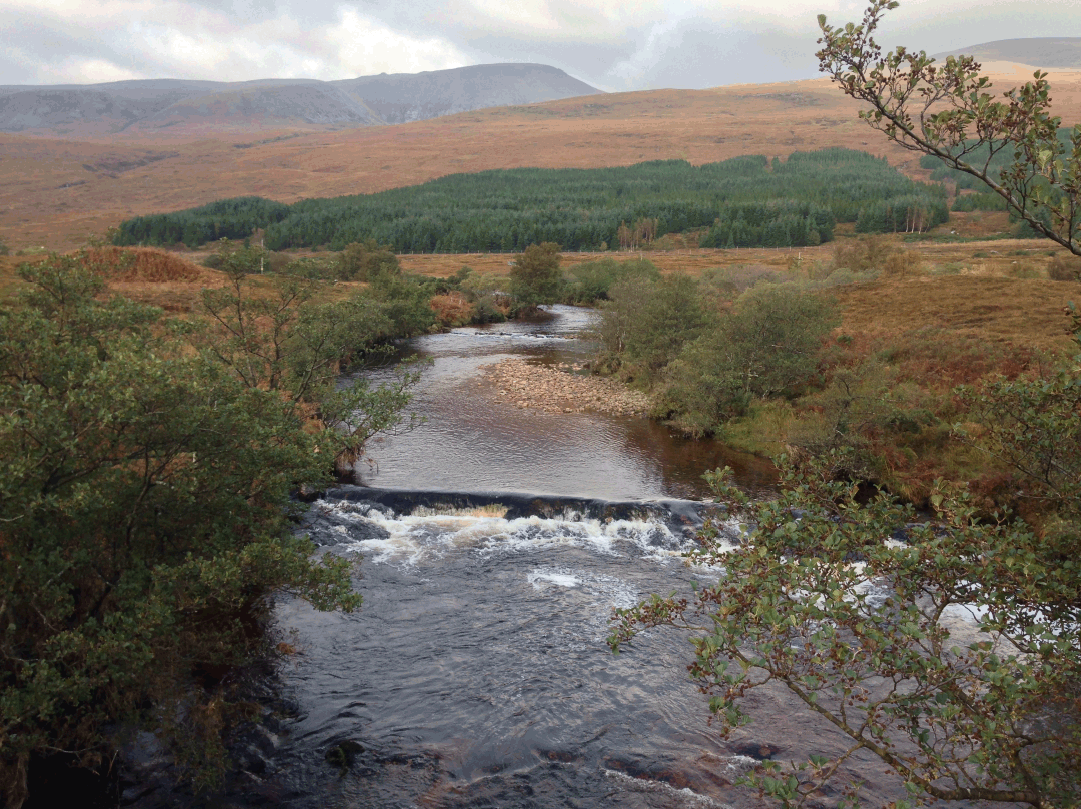
Figure 5.22. River Polla, upstream of the stone bridge near the ocean confluence. Photo courtesy of InStream Fisheries Research.
Model Output and Counter Evaluation for the River Polla
The decision and cost model retained nine technologically and logistically feasible counter scenarios out of a possible 184 for Site 1 on River Polla ( Table 5.16). The channel_type variable removed all counter scenarios where channel_type = "fish pass". Although there is no mains power at the site, mains power is possible and would be the preferred power_type. All counter scenarios with power_type = "battery" were removed. The main variable used to remove the majority of the counter options was min_depth (> 90 cm min_depth required for hydroacoustic counters); this removed all counter options that used hydroacoustic technology.
Limited Capital Budgets
The five least expensive options included video, resistivity and optical beam counters, varying in the types of structures (with and without fences). Video counter scenarios offer the least expensive capital costs starting at £33 010, followed by resistivity counters with flat pad sensors at £33 823 ( Table 5.16).
Although the optical beam counter is ranked fourth in capital cost, its capital cost is 2.3- and 2-fold greater than video and resistivity counters, respectively (Table 5.16). The reason for this large difference in capital cost is due to the relatively large cost of the Vaki Riverwatcher. From a capital cost perspective, the model results indicate that video and resistivity counters would be the most cost-effective options.
Limited Operational Budgets
The five least expensive options over a 10-year operational period include resistivity and optical beam counters. The large cost of operating video counters, attributable to the cost of reviewing video footage to count fish, lead to the worst cost rankings over a 10-year operational period and are typically 4.6-fold higher than the operational costs associated with the resistivity counters and optical beam, which ranged from £60 883 to £65 898 over 10-years (Table 5.16).
The total cost over 10-years (including capital and 10-year operational costs) ranged from £96 841 to £169 631 for the top four ranked scenarios, with scenarios ranked 5 through 9 having a range in total cost of £301 868 to £489 933 ( Table 5.16). The reason for the large increase in cost between scenarios 4 and 5 is related to whether or not a structure is used and if that structure is removable (less expensive) or permanent (more expensive). Scenarios ranked 8 and 9 both use video technology and the high cost over 10 years is mainly attributable to the high cost of reviewing video to count fish. We recommend any of the options included in this set of counter scenarios for Site 1 on River Polla, with the main consideration being the cost of building a permanent structure.
Table 5.13. Decision and cost model output for the stone bridge site on the River Polla. Options are ranked by 10-year total cost, from least to most expensive. Costs are provided in GBP, and cost rankings are provided in parentheses. Res. represents resolution.
| Option no. | Technology | Company | Res. | Counter | No. counters | Sensor | Structure | Structure pad | Counting software | Capital cost | 10-year operational cost | 10-year total cost |
|---|---|---|---|---|---|---|---|---|---|---|---|---|
| 95 | resistivity | Aquantic | NA | Logie 2100C | 1 | flat pad | none | none | automated | 33823 (2) | 63018 (2) | 96841 (1) |
| 97 | resistivity | Aquantic | NA | Logie 2100C | 1 | flat pad | picket fence | none | automated | 37903 (3) | 73315 (7) | 111218 (2) |
| 108 | optical beam | Vaki | NA | Riverwatcher | 1 | NA | floating fence | chain ballast | automated | 76733 (4) | 65898 (3) | 142631 (3) |
| 116 | optical beam | Vaki | NA | Riverwatcher | 2 | NA | floating fence | chain ballast | automated | 103733 (5) | 65898 (4) | 169631 (4) |
| 107 | optical beam | Vaki | NA | Riverwatcher | 1 | NA | floating fence | concrete sill | automated | 235970 (7) | 65898 (5) | 301868 (5) |
| 93 | resistivity | Aquantic | NA | Logie 2100C | 1 | NA | Crump weir | none | automated | 248582 (8) | 60883 (1) | 309464 (6) |
| 115 | optical beam | Vaki | NA | Riverwatcher | 2 | NA | floating fence | concrete sill | automated | 262970 (9) | 65898 (6) | 328868 (7) |
| 4 | video | various | NA | various | 1 | NA | floating fence | chain ballast | none | 33010 (1) | 298586 (8) | 330696 (8) |
| 3 | video | various | NA | various | 1 | NA | floating fence | concrete sill | none | 192247 (6) | 298586 (9) | 489933 (9) |
5.4 Limitations of the Decision and Cost Model
We recognize a number of limitations of the decision and cost model that are outlined below.
Changing costs - The decision and cost model is assumed to produce accurate assessments of feasible technology and costs. Structural and material costs presented in this report are current as of September 2015, however upgrades in technologies and changes in costs of materials are inevitable. Therefore, a major limitation of the decision and cost model is that it is subject to updating and changes in costs should be considered at the time of counter site construction.
Integrating technologies - There is great value in combining technologies to generate creative applications of technology to fisheries stock assessment. A major limitation of the decision and cost model is that it only considers conventional fish counter technologies and is unable to account for the value of combining technologies.
Biases - The decision and cost model seems to work best for small- to medium-sized rivers (i.e., bankfull widths < 40 m). This bias toward smaller rivers is because of the inherent difficulty with installing and operating fish counters on large rivers. Most of the successes with fish counters have been on smaller rivers. Assessments of larger rivers requires different types of Technologies to be combined or unique counter setups that are not typically applied to most smaller rivers (see Section 6.0 - Opportunities for Combining Technologies for examples). While the generality of the decision and cost model makes it useful across a large number of rivers in Scotland, it reduces its effectiveness when applied to larger rivers that require more specific applications.
Risk assessment - The decision and cost model does not account for risk associated with manufactures, or the operations of different counter setups. It provides a general reference to the risks but does not evaluate counter scenarios based on risk as it does costs. The model user should assess risk.
Contact
There is a problem
Thanks for your feedback